Jean-Martin Charcot and Paul Richer : Building a bridge between neurology and art
Budapest, 24 septembre 24th, 2011

Budapest, 24 septembre 24th, 2011

First of all I would like to express my gratitude to the organisers, it's a great honor to be there for this wonderful meeting. My special thanks will go to François Blanchette of the Teva company who has been so helpful in so many circumstances. The topic of my talk will concern the relationship between Jean-Martin Charcot and his student and then collaborator, Paul Richer, and beyond, some reflexions about the idea of imitation.
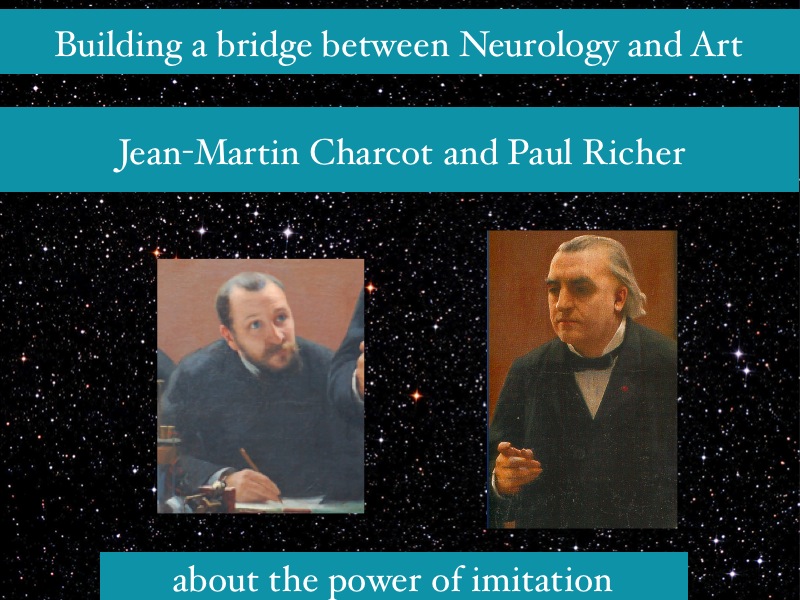
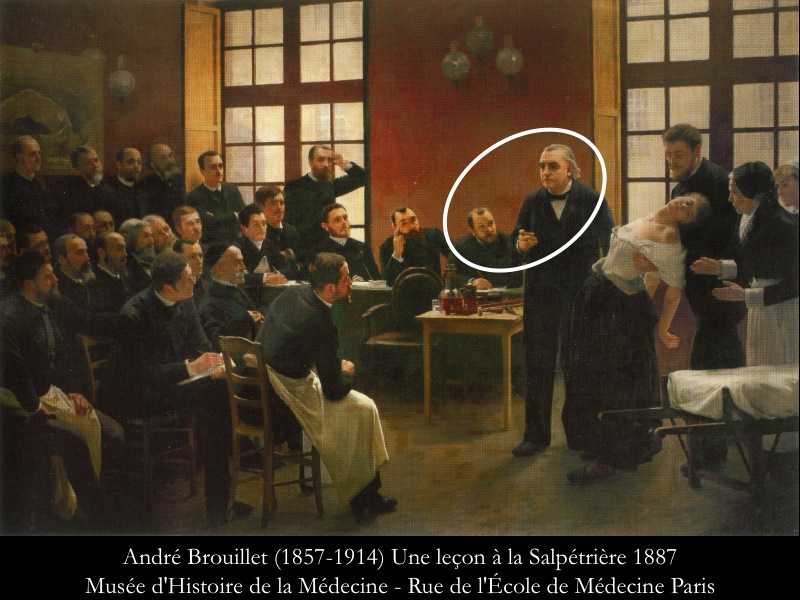
This is perhaps the most known neurological painting : a lesson at the Salpétrière, a very huge painting, more than four meters large, done in 1887 by André Brouillet, an academic painter. To give you an idea, one year before, the last impressionist exhibition has been held in Paris. I shall not speak about each of the thirty three characters depicted here. What I would rather do, is to describe more than the anatomy, the physiology of this painting : how does it work ? Focussing on the relationship between Charcot and Paul Richer, who is sitting here at the right side of Charcot, very attentive. Paul Richer was, at the time of this painting, both a neurologist and a teacher of anatomy at the school of fine arts in Paris, l'école des Beaux Arts.
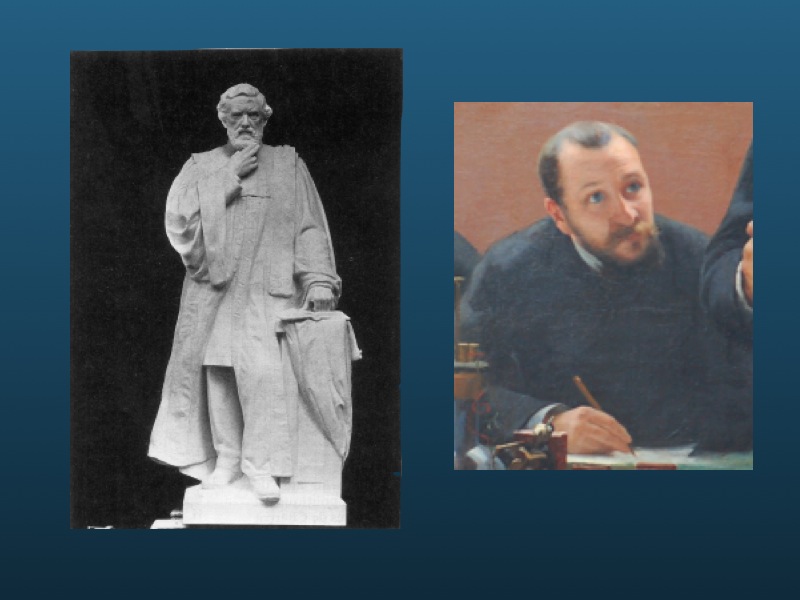
Some important people are missing : among those, Vulpian, the main collaborator of Charcot on the topic of Multiple Sclerosis, who died in may 1887, that year Brouillet has done the painting. This is a plaster by Richer for the his commemorative statue.
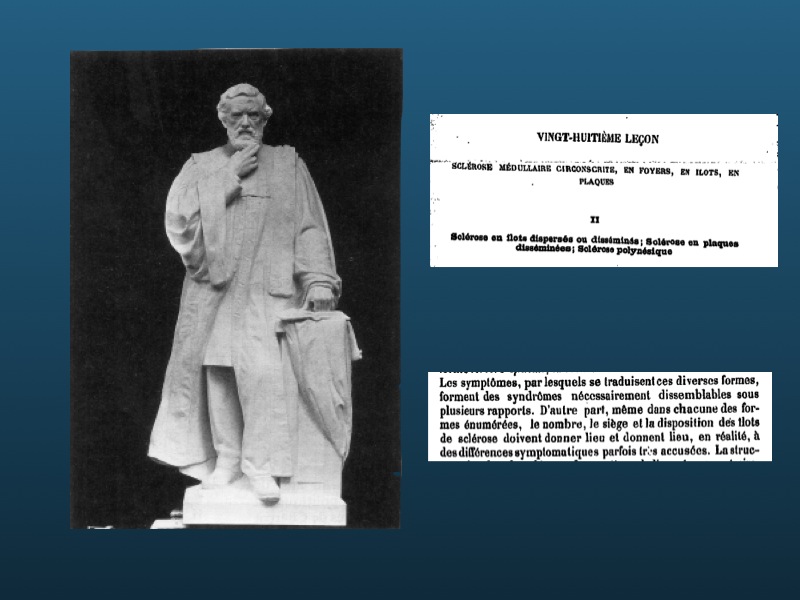
Here are some early illustration of multiple sclerosis lesions. Carswell’s, in 1838. Babinski’s thesis in 1885. Vulpian pointed out, in his lessons, the polymorphism of the clinical picture, as a consequence for the anatomical variability of the lesions, both in number and in localisation. Following Vulpian, it was sometimes if not often impossible to do the diagnosis while the patient was alive.
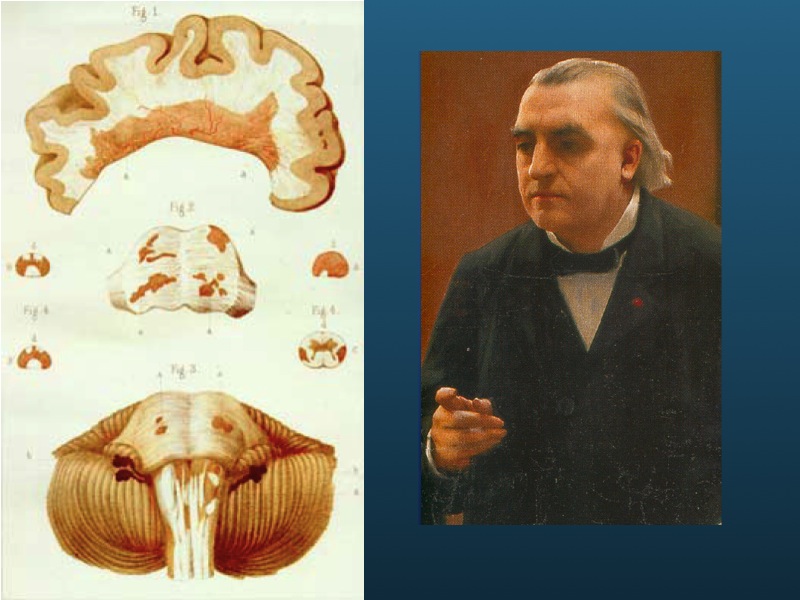
This was not exactly the opinion of Charcot. The first patient with multiple sclerosis he saw was one of his maids : she had dysarthria, ataxia, and tremor ; the so-called Charcot's triad. He thought she had somme kind of syphilitic disease, but at the time of autopsy, he found multiple sclerosis lesions : plaques of sclerosis. For the second case, he did the diagnosis when she was alive, and that was confirmed by autopsy. So to Charcot, with a little training, diagnosis of multiple sclerosis was not supposed to be so difficult.
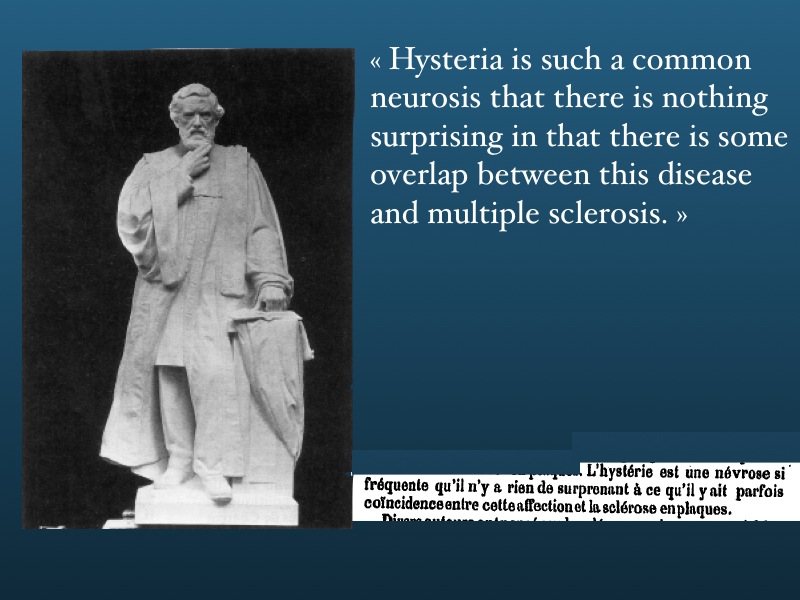
Another point of disagreement between Charcot and Vulpian was the nature of hysteria. Here is a quotation from Vulpian's medical lessons : « Hysteria is such a common neurosis that it's not surprising in to observe some overlap between this disease and multiple sclerosis. » Vulpian, aswell as Sydenham two centuries before, thought that Hysteria was nothing but a chameleon-like disease, the great imitator.
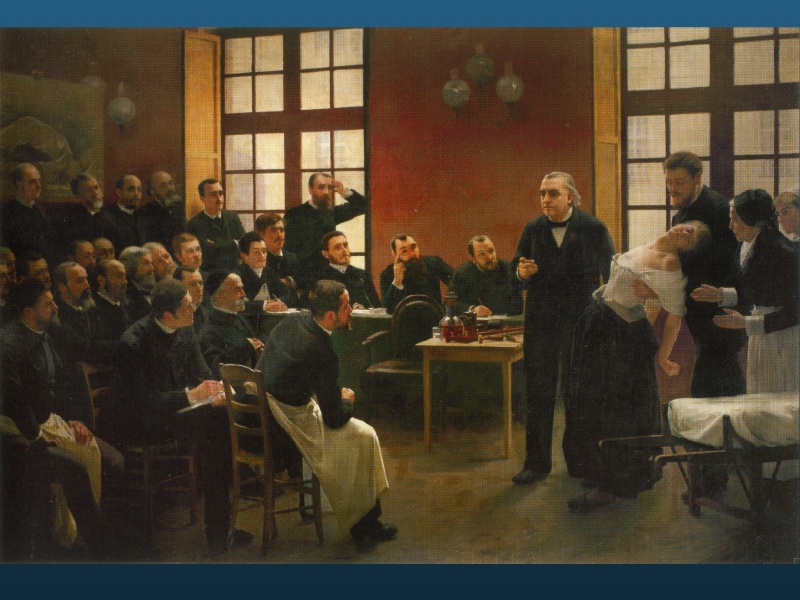
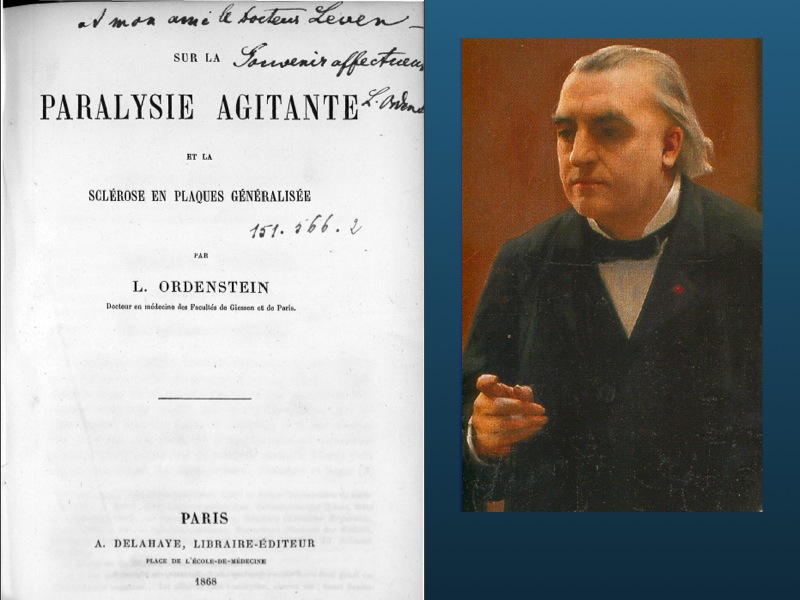
Charcot's opinion about hysteria was strictly the opposite : hysteria was all but a proteiform pathological process. He thought the symptoms and signs of hysteria to be very precise and organised. Hysteria was a disease of its own. I wanted, when I started to work on this topic, to find some link between multiple sclerosis and hysteria, two main Charcot's concerns. I do not pretend that I found one, but let me expose a process of mind that goes from the first to the second.
It started with the reading of Ordenstein thesis. Ordenstein was a german student, who has done a thesis under Charcot's direction, about the differential diagnosis between shaking palsy and multiple sclerosis. If someone tells you nowadays that he has a problem distinguishing parkinson from multiple sclerosis, it may sound strange even if we know that this happens occasionally.
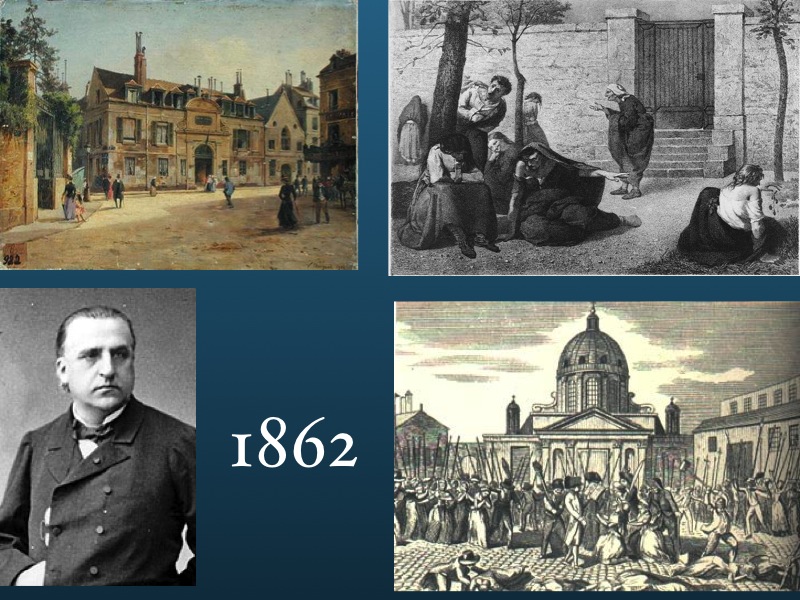
To understand why this differential diagnosis was such a problem in 1868, one must first go back in the passed, exactly in 1862 when Charcot arrived in la Salpétrière, a little town in the big Paris, with a church, courtyards, streets, small three-floors blocks, sheltering six thousand women with all kind of diseases.
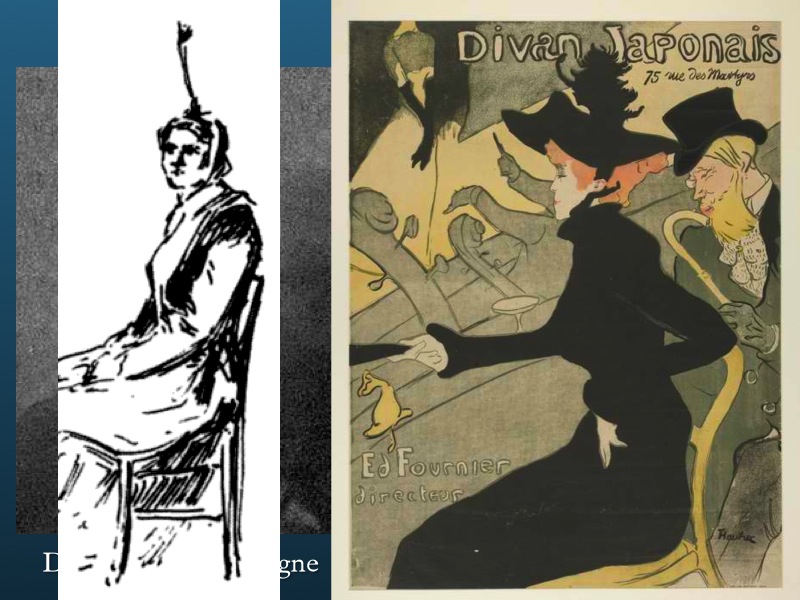
Duchenne de Boulogne was running from one hospital to another and within the Salpétrière, from one block to another, carrying a box and two electrodes to test the muscles, setting the foundation for muscle diseases nosology. Duchenne was older than Charcot, and he taught him some clinical tricks in such a way that Charcot used to call him his master. One of the clinical tricks, was the feathered hat sign : look at the poster by Henri de Toulouse Lautrec: You see this woman wearing a hat with a high feather on top of it. Her name is Jane Avril, a former cabaret dancer, then an in-patient at the Salpetriere, and at the end she was taken in by prostitutes. Duchenne would say to Charcot : to amplify a tremor, for a better analysis, you should set on top of the head of your shaking patients such a feather. Why do I talk so much about feathers?
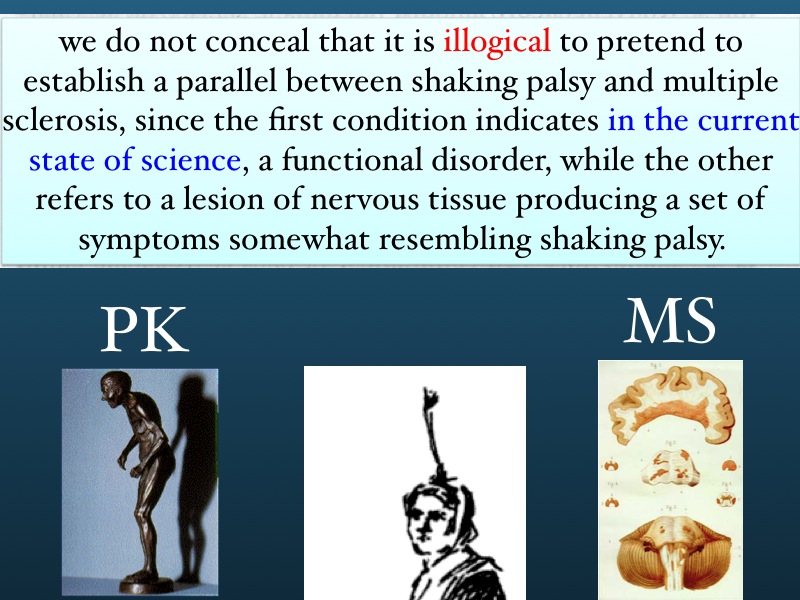
There is a very important paragraph in the thesis of Ordenstein : every word here is important. « We do not conceal that it is illogical to pretend to establish a parallel between shaking palsy and multiple sclerosis, since the first condition indicates in the current state of science, a functional disorder, while the other refers to a lesion of nervous tissue producing a set of symptoms somewhat resembling shaking palsy ». Shaking Palsy - Parkinson disease - was then a functionnal trouble (no lesion has been found yet in Parkinson disease) while multiple sclerosis was a lesional disease ; but both they led to the feathered hat sign : they provoked both the same kind of symptoms.
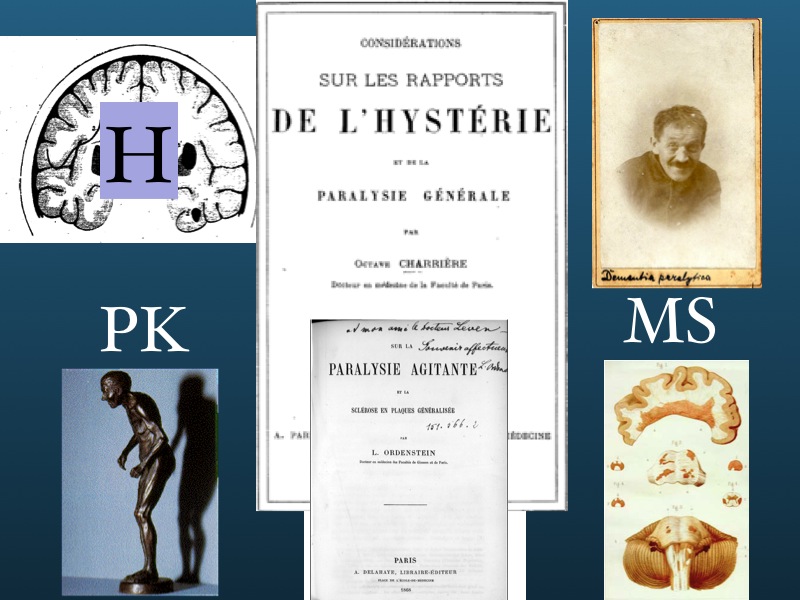
Now let's leave the subcortical level - the level, in Charcot's thought, of motricity, sensitivity, coordination, stiffness... and let's jump to the level of hysteria. Which is, following Charcot's conception, a functional disorder of the cerebral cortex. Here is a very appropriate work by Octave Charriere, published in 1882, about the overlap between hysteria and general paralysis, which was called Bayle's disease or Dementia Paralytica at the time. In France, the syphilitic origine of it was not yet admitted by the most influencial specialists. So you realise that Octave Charriere's memoir plays the same role, between hysteria, functionnal cortical disorder, and dementia paralytica, lesionnal disase of the brain cortex, than Ordenstein thesis, between Parkinson considered at the time as a functionnal disorder, and Multiple sclerosis, paradigm of subcortical lesionnal disease. And now you see the potential strategic importance of Multiple Slerosis in the progression of Charcot's thought.
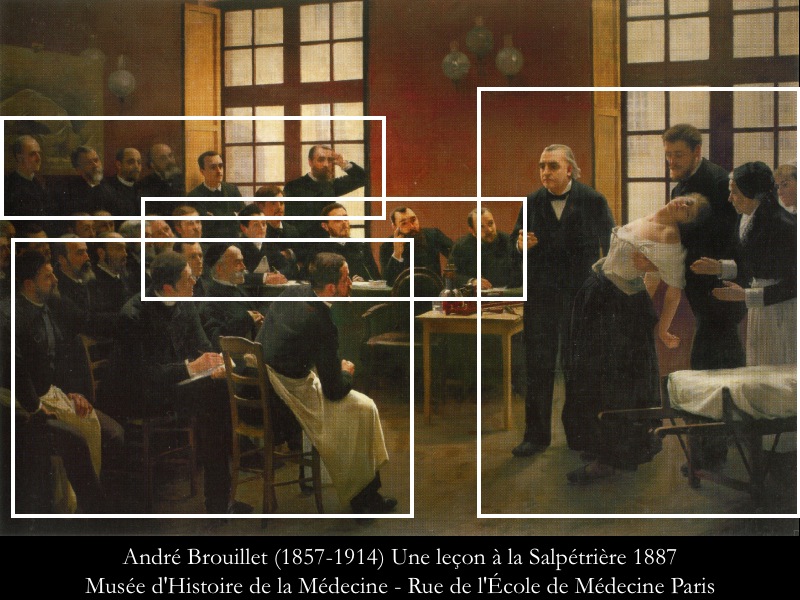
Let’s get back to the Lesson of Brouillet : obviously there are different groups. Some standing people on the background on the left, not very attentive ; a sitting group, at the right of Charcot ; the very attentive ones, they sit in the foregroung on the left, listening to Charcot's commentaries about Blanche Wittmann, one of the stars of the Salpétrière's hysterical team at the moment.
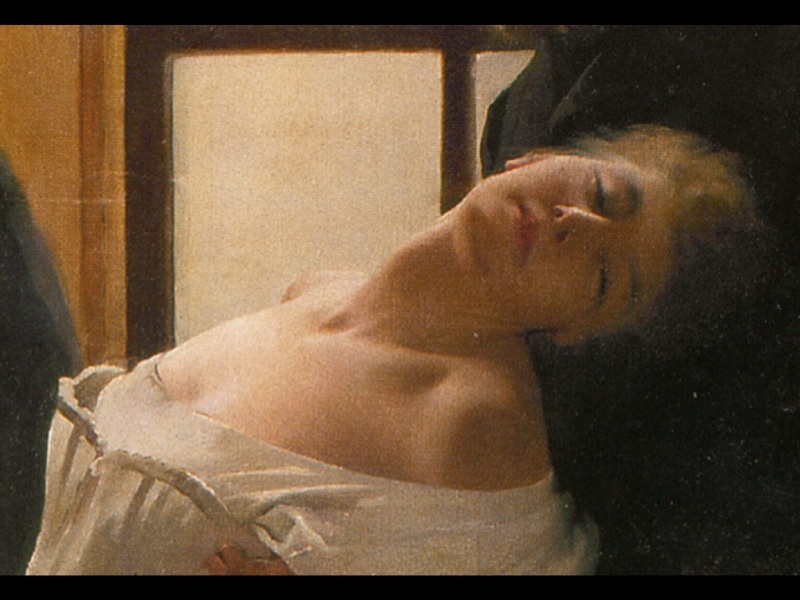
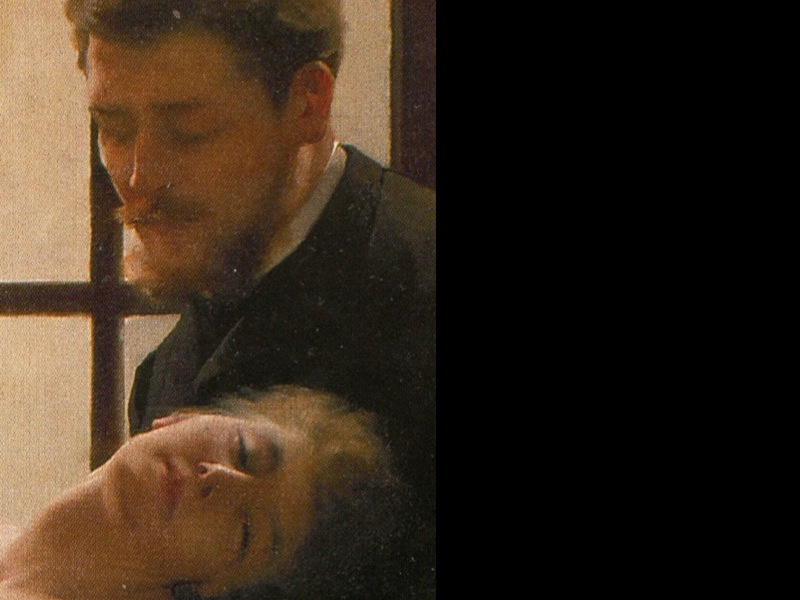
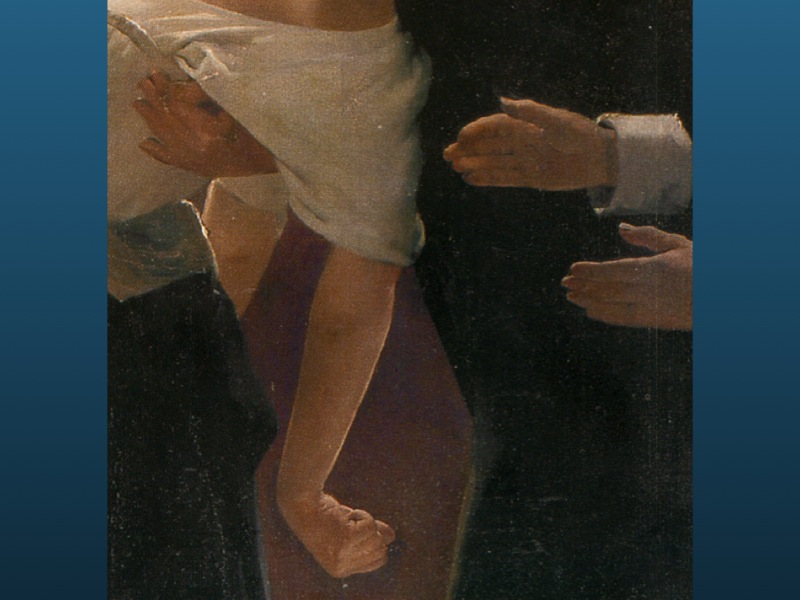
She falls in the arms of Babinski, and not in those of Marguerite Bottard, the oldest of the two nurses who stand ready to rescue her ; nor on the strecher, waiting on the foreground, just in case. Here you see Blanche, Blanche and Babinski, and the most known superior limb of neurological history : look at the forearm, wrist, fingers, one could talk about a kind of dystonic posture.
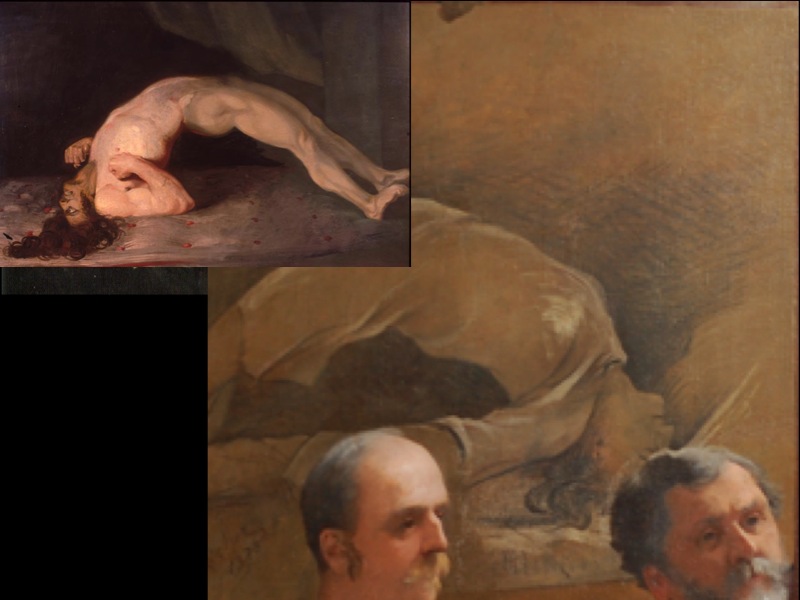
The all of you know that a picture is hanged on the opposite wall. If you have good eyes you can read : period of contorsions. It's a pseudo-opistotonus. Not a real one, as we know since this wonderful and awful illustration of tetanus by Charles Bell himself : here you see the unfortunate english soldier suffering from tetanus. The contraction of the forearm is different.
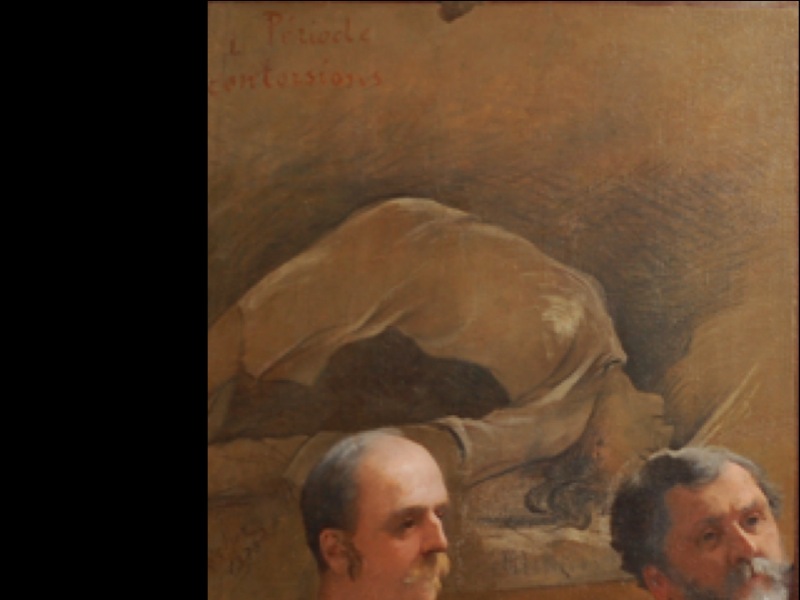
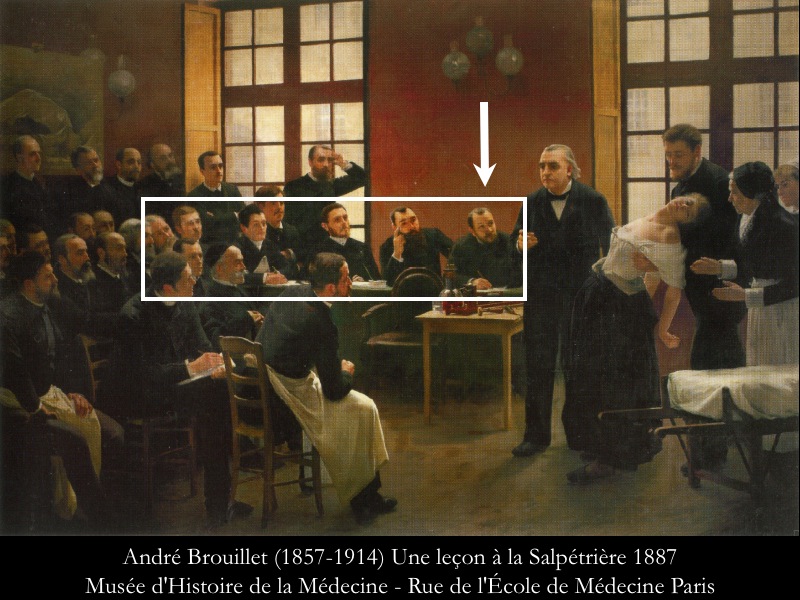
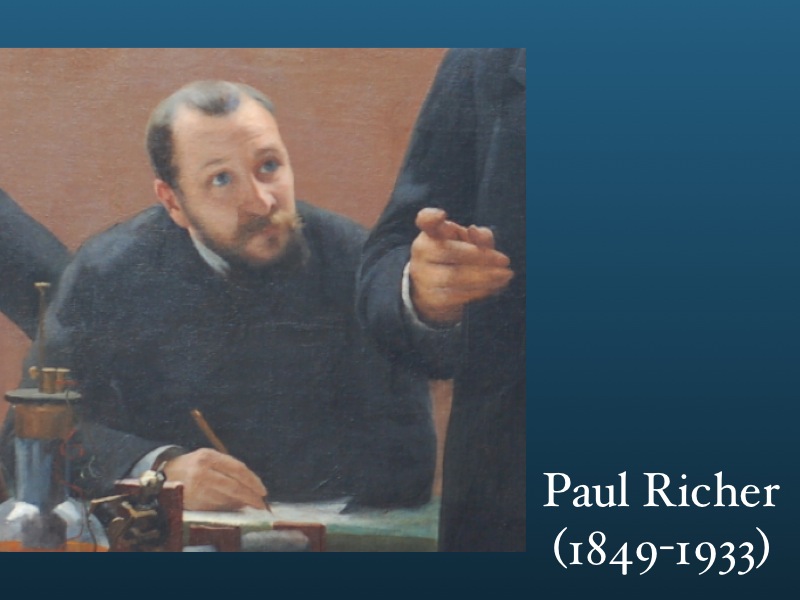
Who did this poster ? Paul Richer. It's time to tell you a little bit more about him. Paul Richer was very gifted for drawing aswell as modeling ; he was asked by his friend Paul Meillet to illustrate a thesis about The permanent deformations of the hand. At the origin of the thesis was Jean-Martin Charcot, who, enthused by the drawings, would have say : one could make the diagnosis on these drawings !
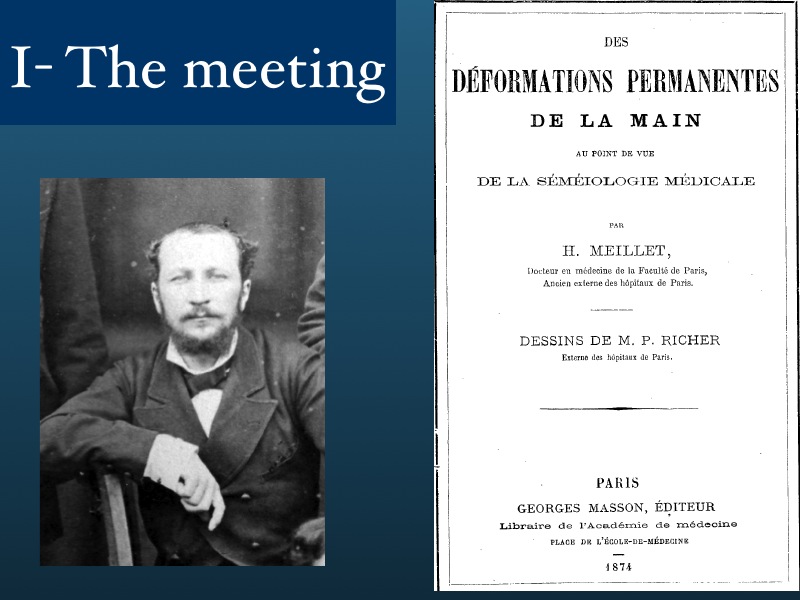
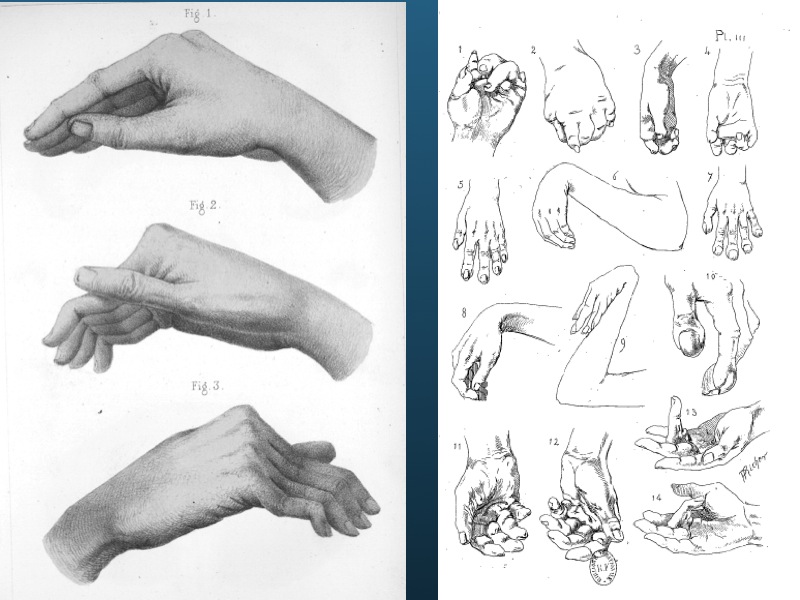
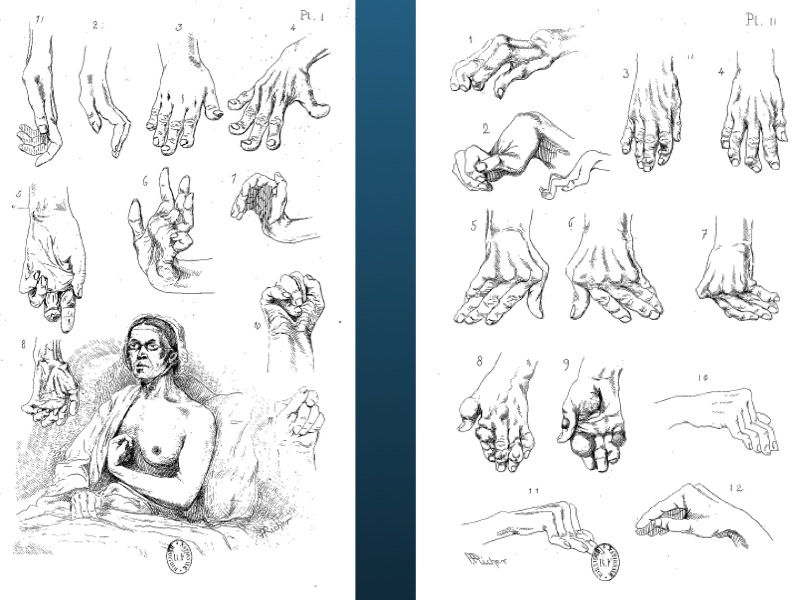
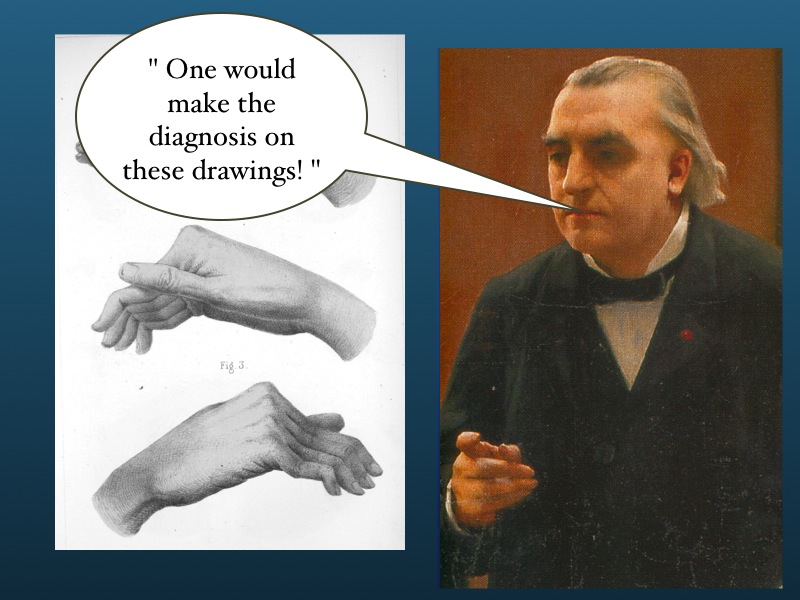
Then he told to Richer : do your internship, and I take you in my department during the last year. And so they did. This is one of the first illustrations Richer did for Charcot, at the beginning of is internship.

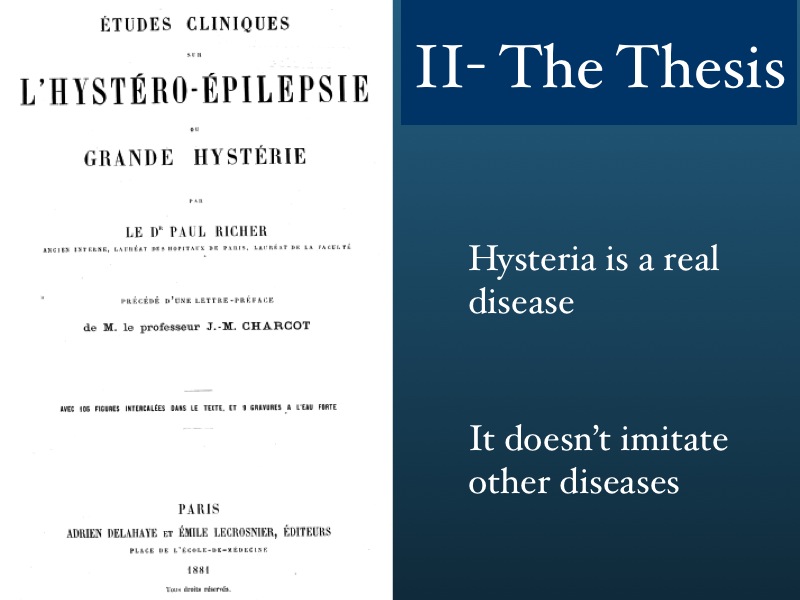
Thus, Paul Richer began writing a thesis, A Descriptive Study of the great hysterical attack, following the two main ideas of Charcot : Hysteria is a real disease, and hysteria does not mimic any other disease. In order to demonstrate that the great hysterical attack followed a constant pattern, they distinguished four periods, eight phases.
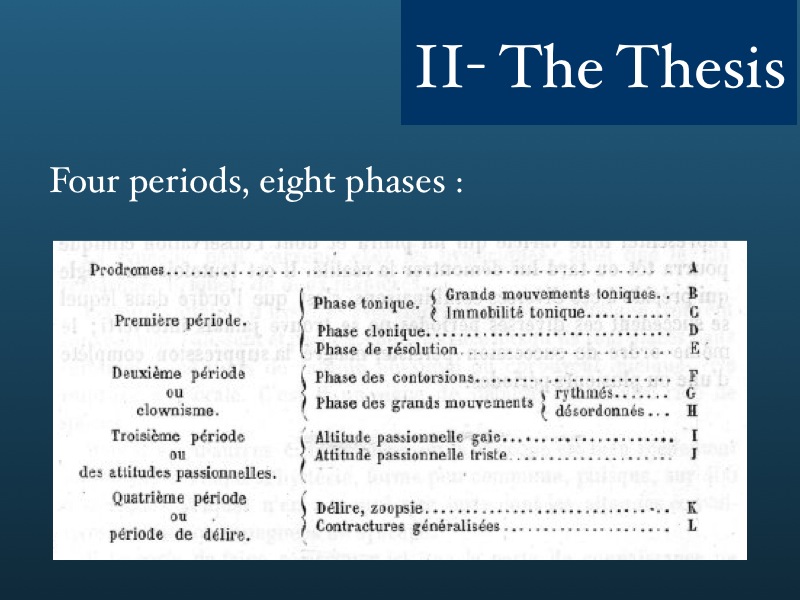

Look at this pannel of sketches all done by Richer himself : they are organised in four periods, epileptoïd, clownism, passionate attitudes, delirious.
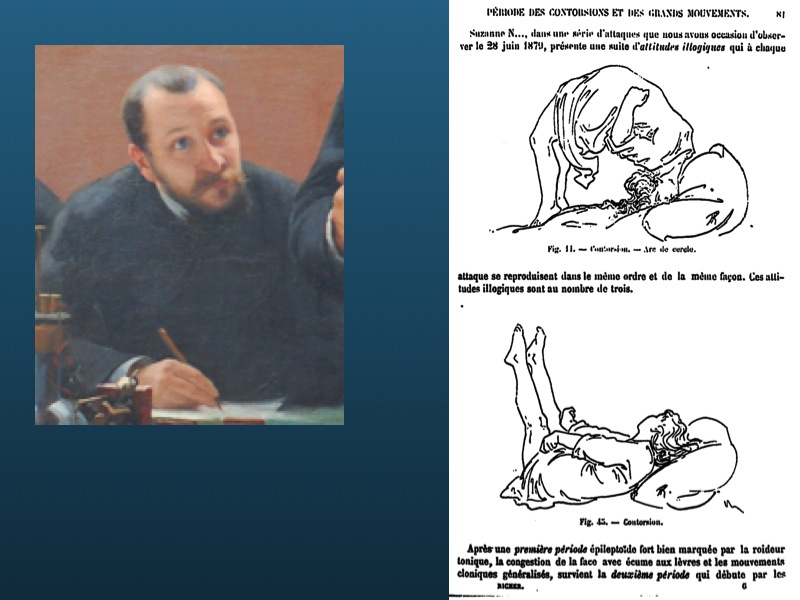
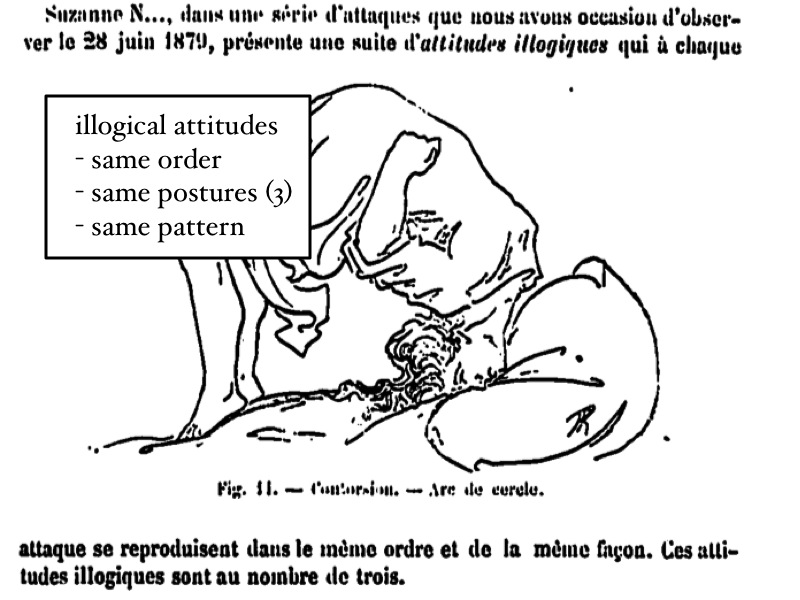
How Richer did to catch all these illogical attitudes, as he used to call them ? He would stay for hours at the bedside, for example, at Suzanne's, who experienced on the 28th of june 1879, a cluster of attacks, which happened always as a sequence of illogical figures in the same order and in the same manner. This is exactly what wanted to demonstrate Charcot : the constancy of the pattern of the Great Hysterical Attack.
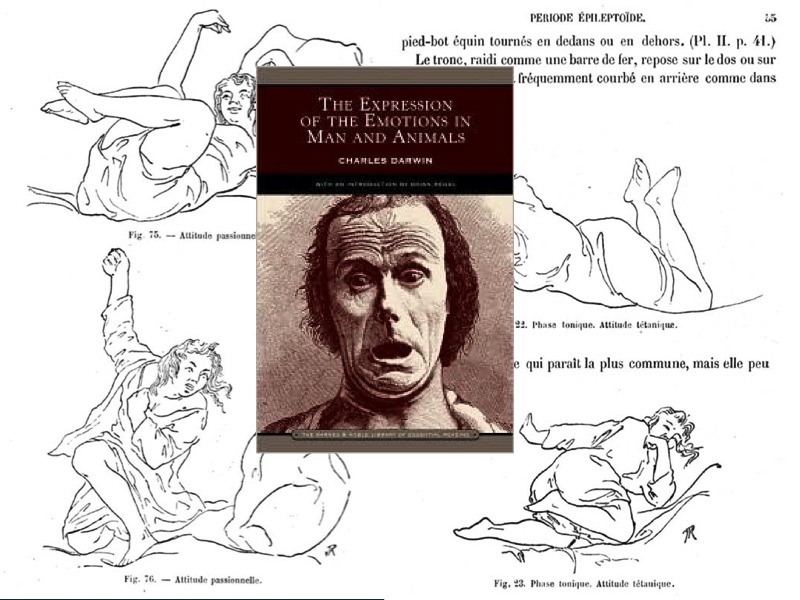
Now let's have a look to these sketches depicting what they called passionate attitudes. The word Passion is still used by Charcot and Richer, although since a long time scottish philosophers and then english men of science - I think about Darwin - use instead of Passion the word Emotion. Well passion meant at this time joy, sadness, disgust, terror, anger, asthonishment, admiration, pride, shame…
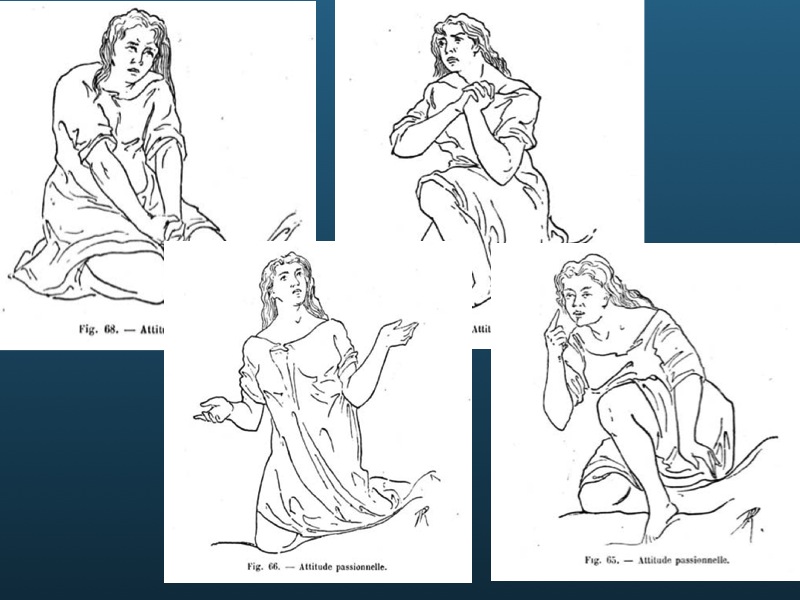
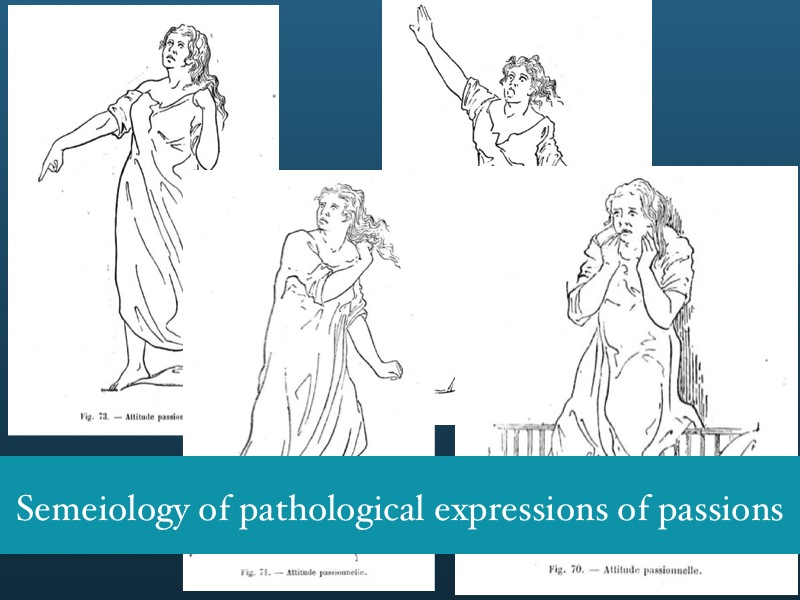
The idea of Charcot about Hysteria is that it's a disorder of the expression of passions. If I hear a sad song, I shall have a sad expression on my face. While in Hysteria, the expression happens out of purpose, out of proportion, exagerated, theatrical. Charcot wanted to brush with Richer the semeiology of pathological expressions of passions.
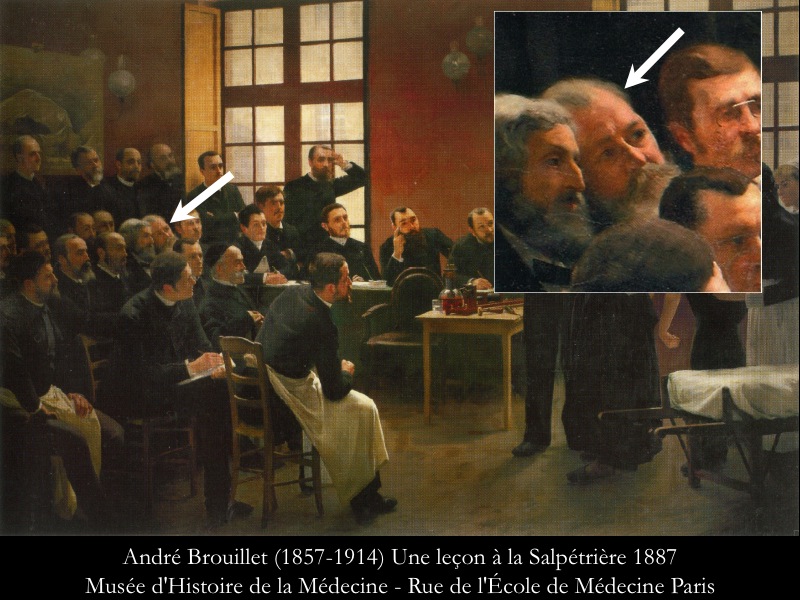
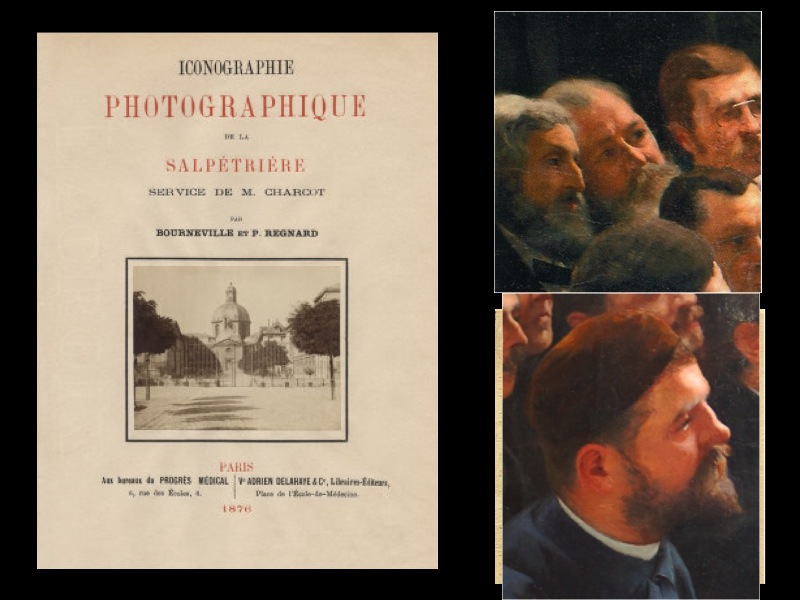
But sketching was not enough. So Charcot asked Bourneville, one of his earliest collaborators, to organise with the physiologist Paul Regnard and then Albert Londes the first photographical iconography department in la Salpétrière. They worked together with Richer.
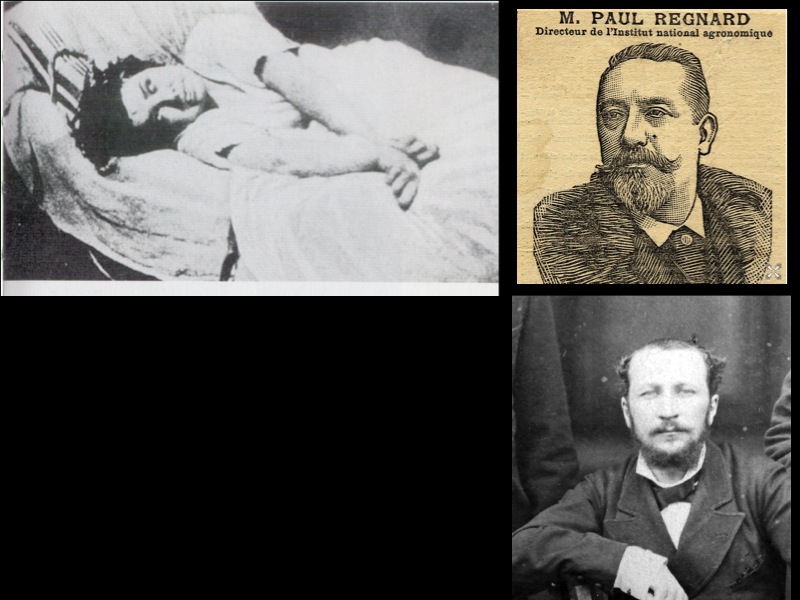
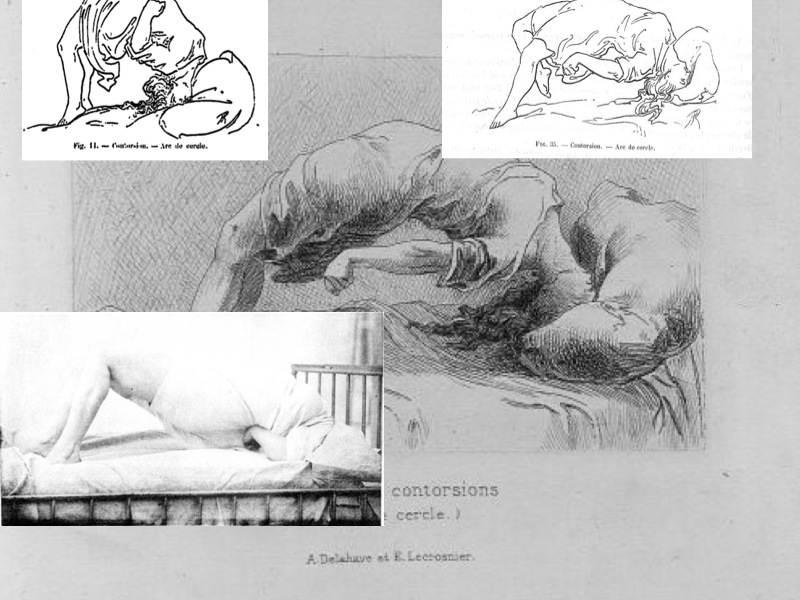
Let's take an exemple of how they proceeded : this girl has an attack ; Regnard takes a picture ; then Richer makes a drawing, after the picture. Another exemple : the contortion's illogical attitude is photographied by Albert Londes, then Richer makes a drawing after the photograph. You noticed the difference of the forearm position. In fact Richer has chosen one amid two of his own sketches, rather than the photography. Here is the installation to take pictures at the bedside : Albert Londes who is wearing a small cap, an apron and a beard, is ready to press the button.
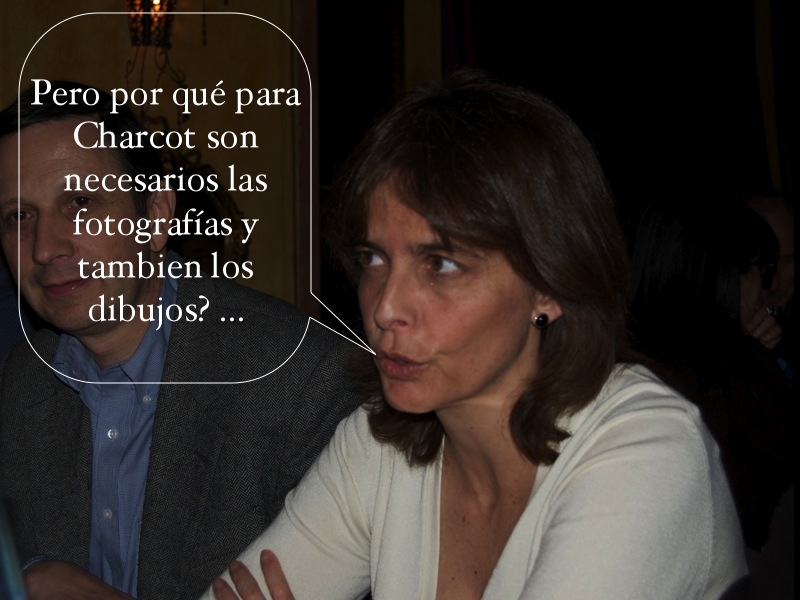
Pero por qué para Charcot son necesarios las fotografías y tambien los dibujos? ... Why Charcot needed both photography and drawings ? This is quite a good question.
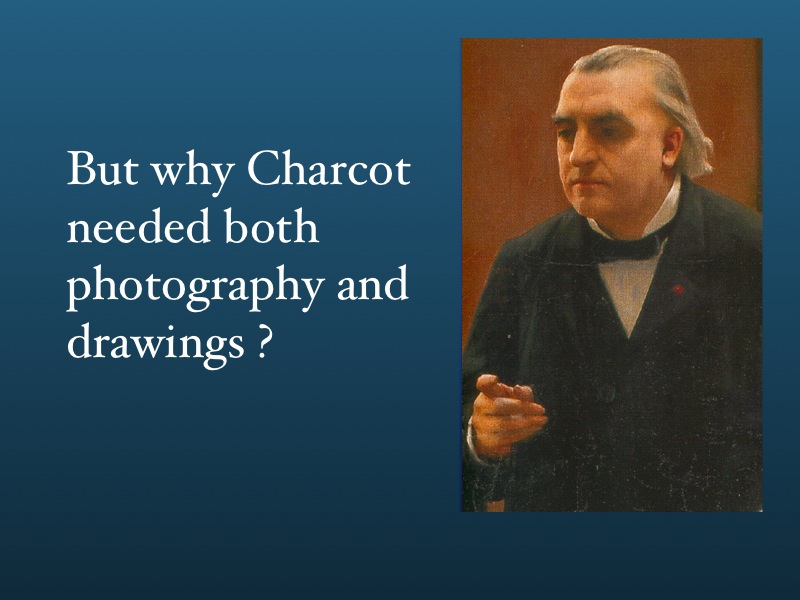
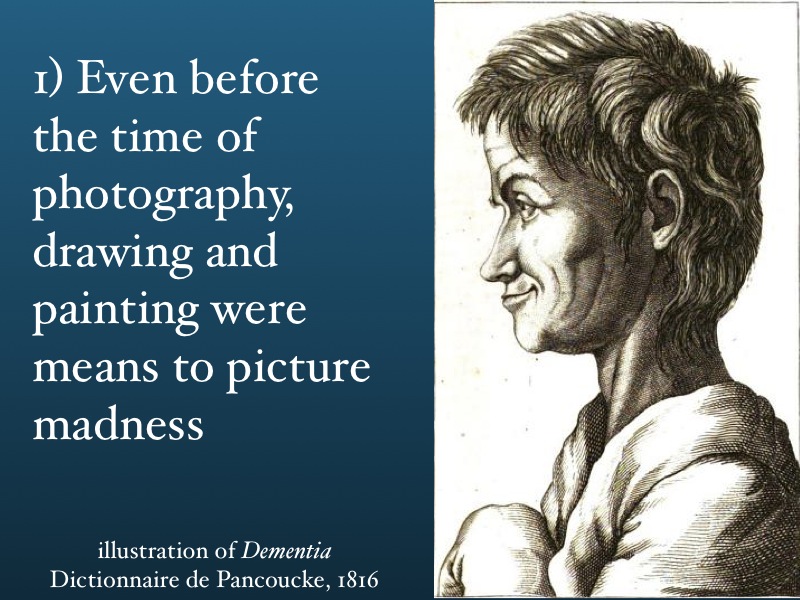
Maybe there are several answers. Even before the invention of photography, drawing and painting were means to depict madness ; as this illustration of dementia, dated 1816.
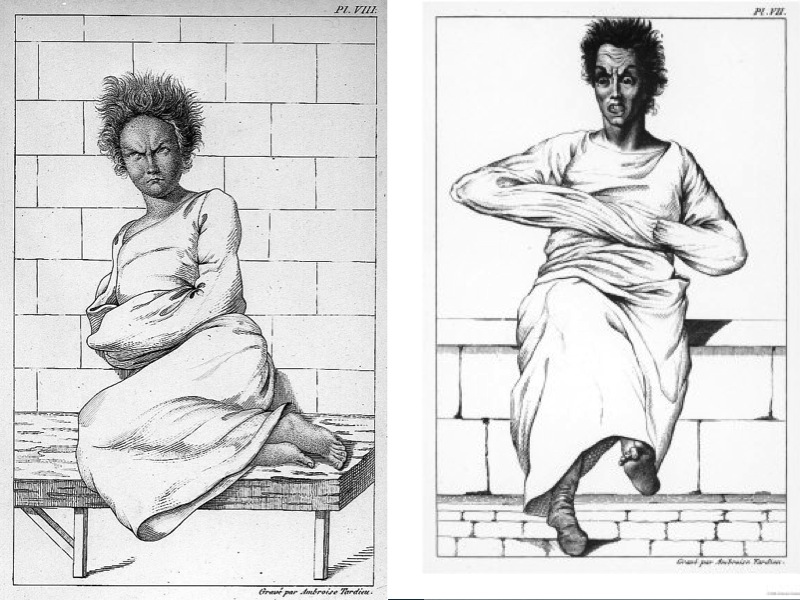
These illustrations by Ambroise Tardieu for the last work of Esquirol, in 1837. I have no time to comment the marvellous monomaniacs painted by Gericault at the request of an alienist, Georget : envy, gambling, kleptomania, military commandment, kidnapping... One thing is sure : since a long time people believed that insanity was readable on someone's facial features.

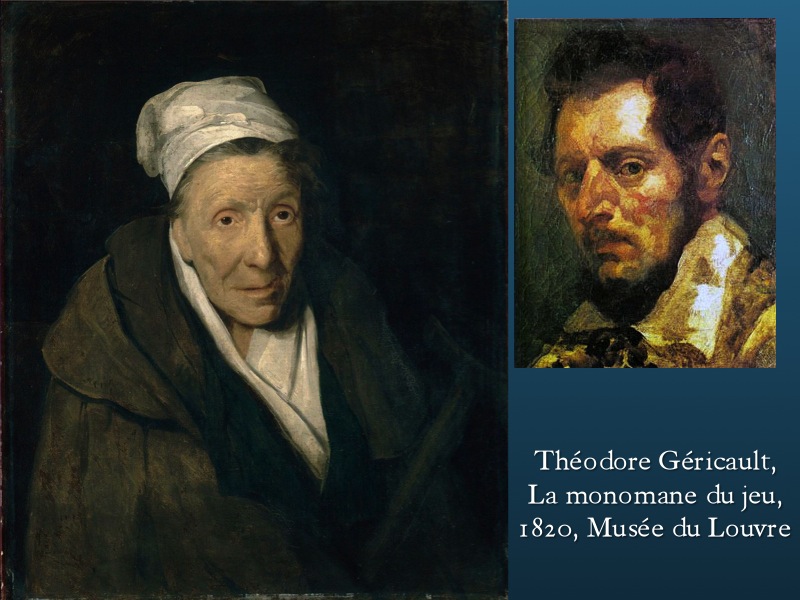
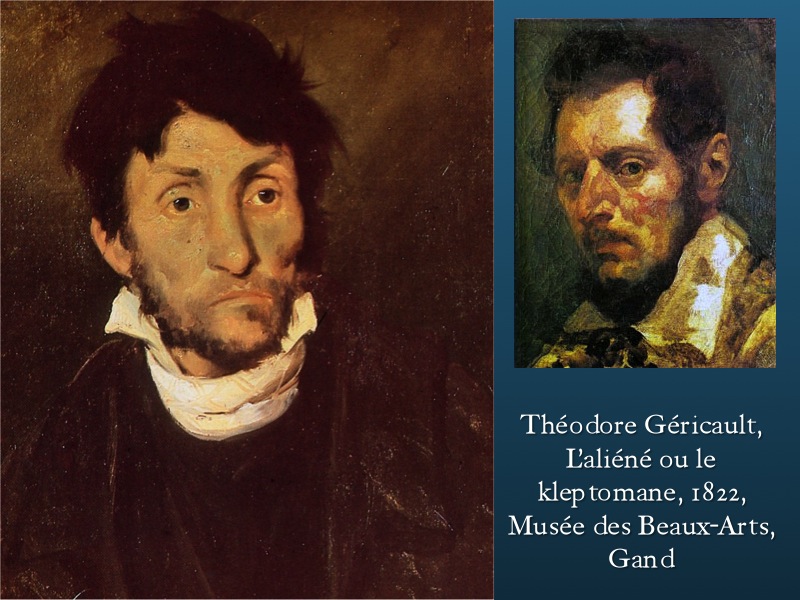
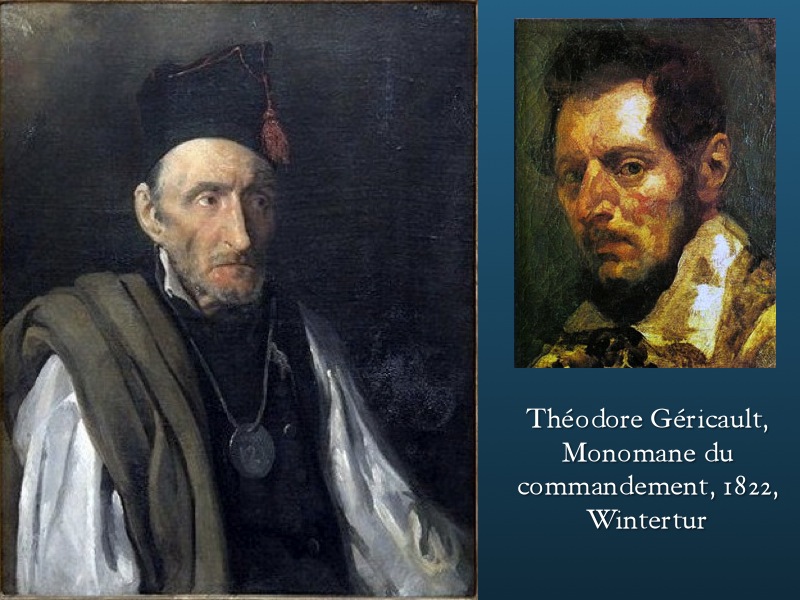
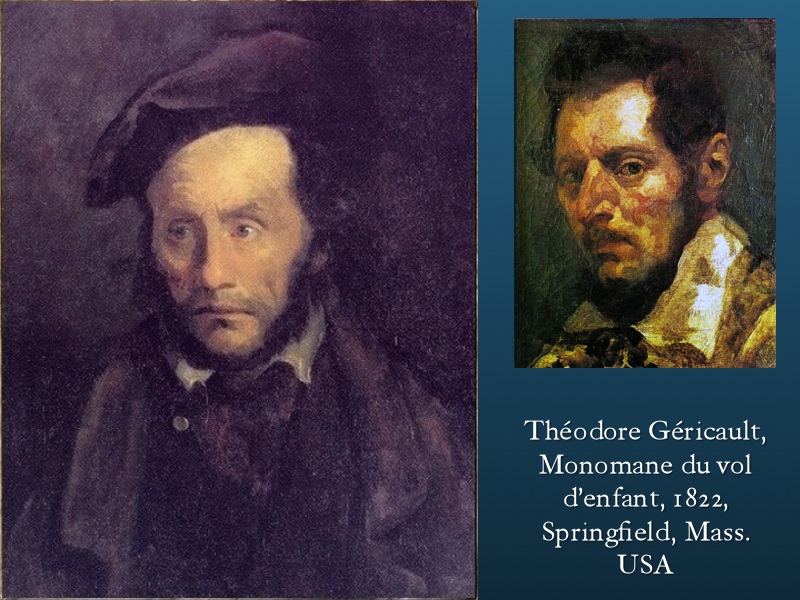
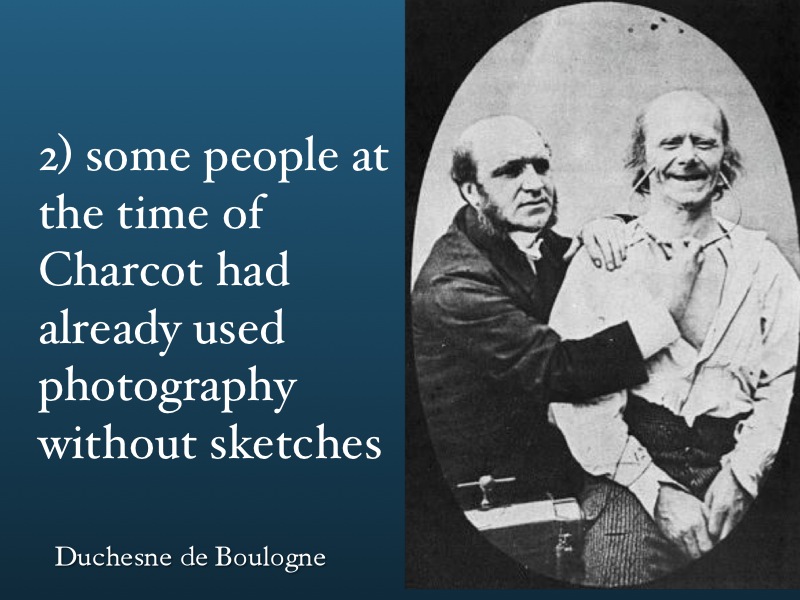
On the other hand, some colleagues of Charcot used photographs but not drawings : for exemple, Duchesne de Boulogne. In his Mecanism of human physionomy, he tried to produce experimentally all kind of expressions of passions using two electrodes : joy, sadness, fear, terror, anger...
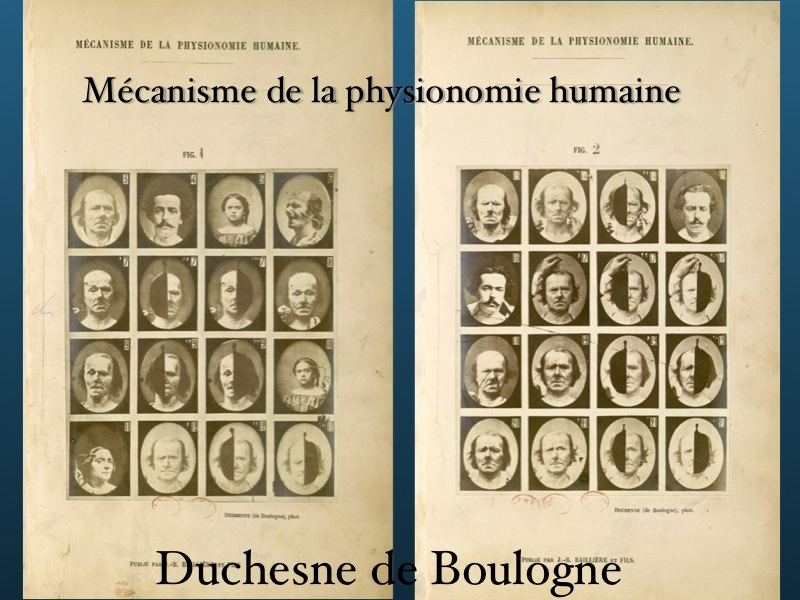
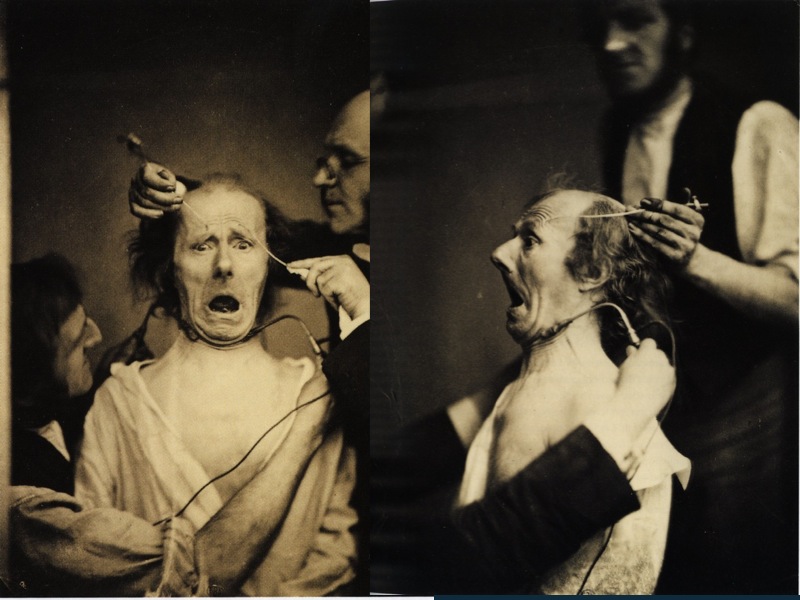
To reproduce terror, he needed an assistant, and four electrodes.
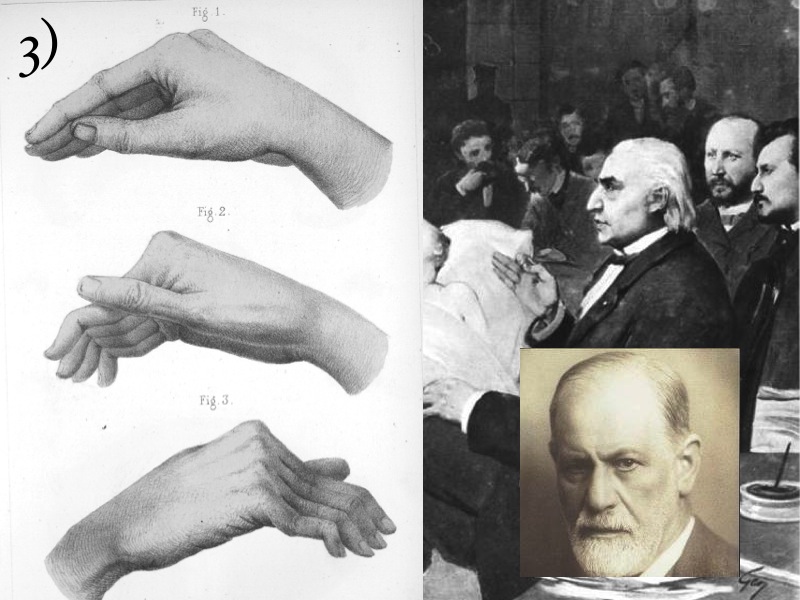
So, why both photographs and drawings ? At last a first answer : I shall call the testimony of Sigmund Freud himself, who spent four monthes, during the winter 85-86, in the department of Charcot : he used to tell about him, that he was a visual man : not in the meaning of visionary ; in the meaning of intuitive recognition of shapes. The recognition of a disease's essential features. Remember how he was astonished by the drawings of Richer.
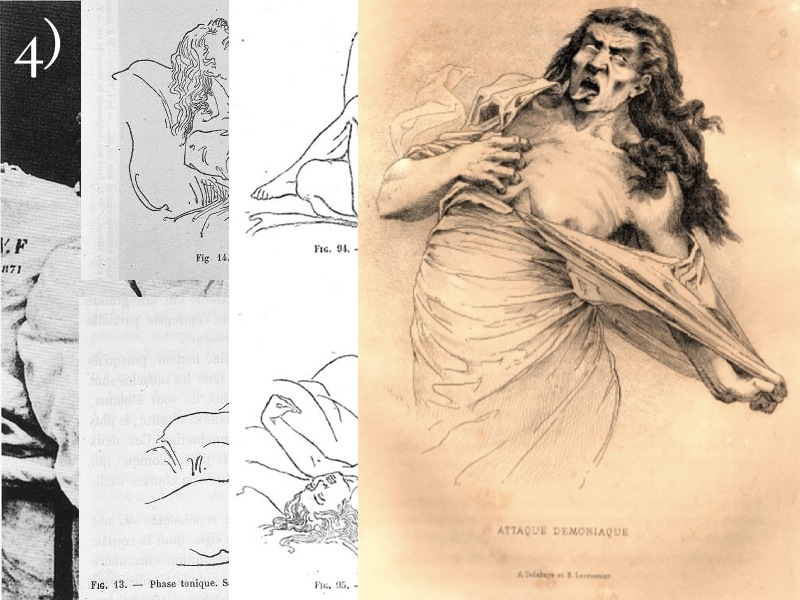
Then a second answer. Consider this set of illustrations : first a photography of Angelique, one of the challengers of Blanche Wittmann, having a demonic attack, with the tongue thrown out of the mouth, one could think about the exorcist, the famous movie. Then the sketches done by Paul Richer. Then this very elaborate drawing.
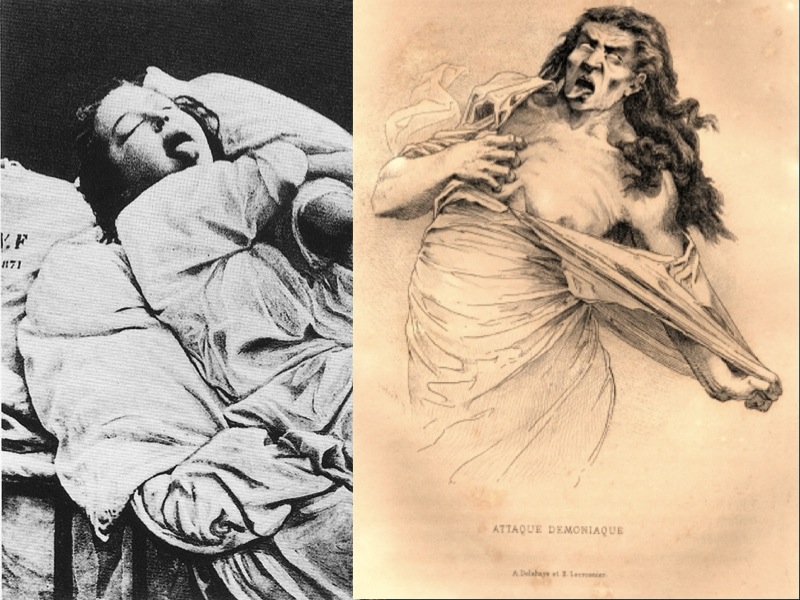
So what is the difference between photography and drawing ? On the first you will recognize a person, you may have other pictures of the same person ; if you don't know her, you will ask, who's that girl ? But the main topic of this drawing is the idea of demonic attack, built by an artist. You don't care about who is represented : it's more a question of what is presented. Here I have to mention a very important idea that was put forward by de Alberti and Leonardo da Vinci : drawing and painting are cose mentale. Il means : constructions by the artist's mind. They are not at all some kind of imitations.
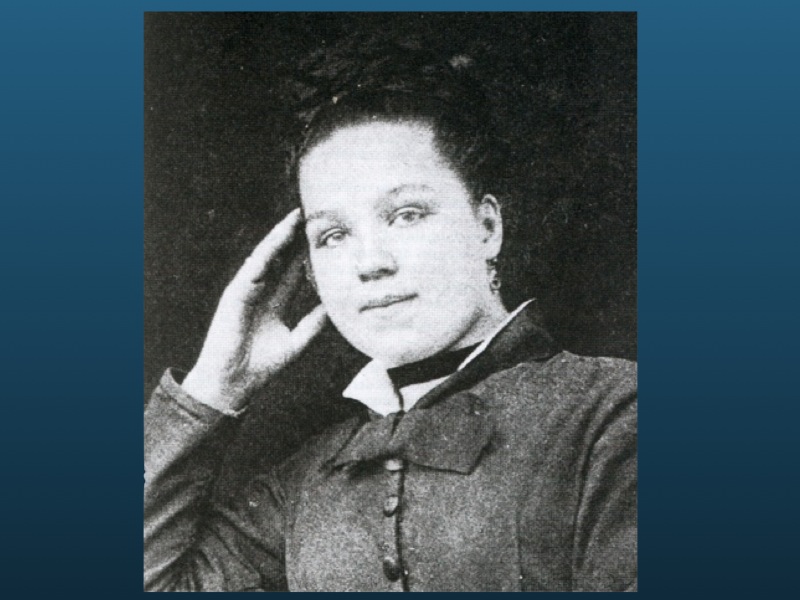
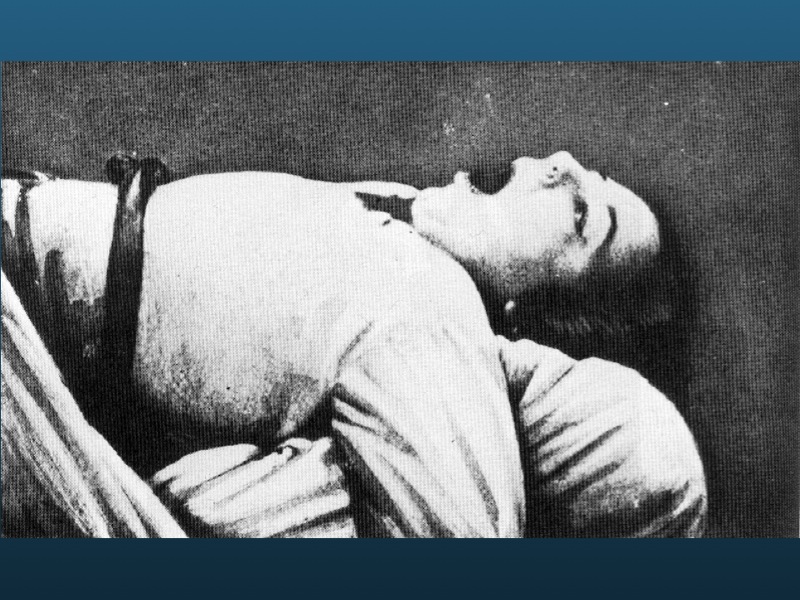
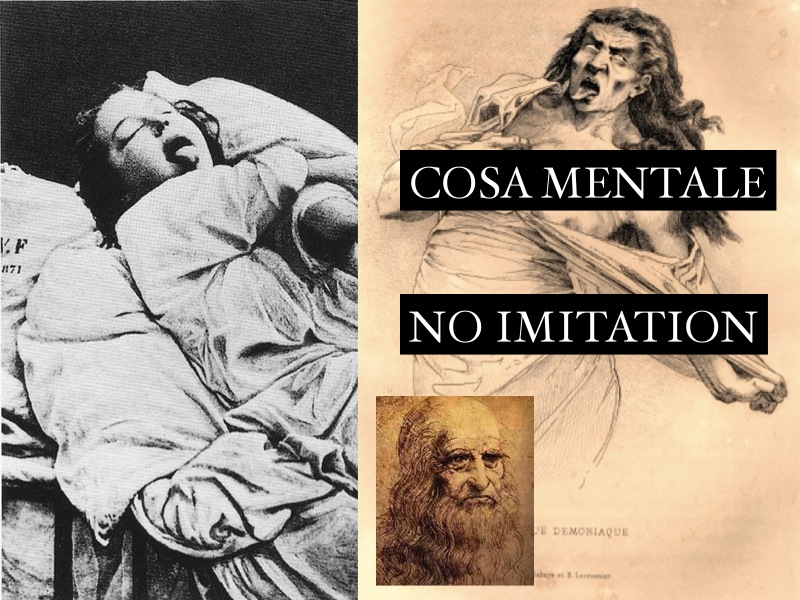
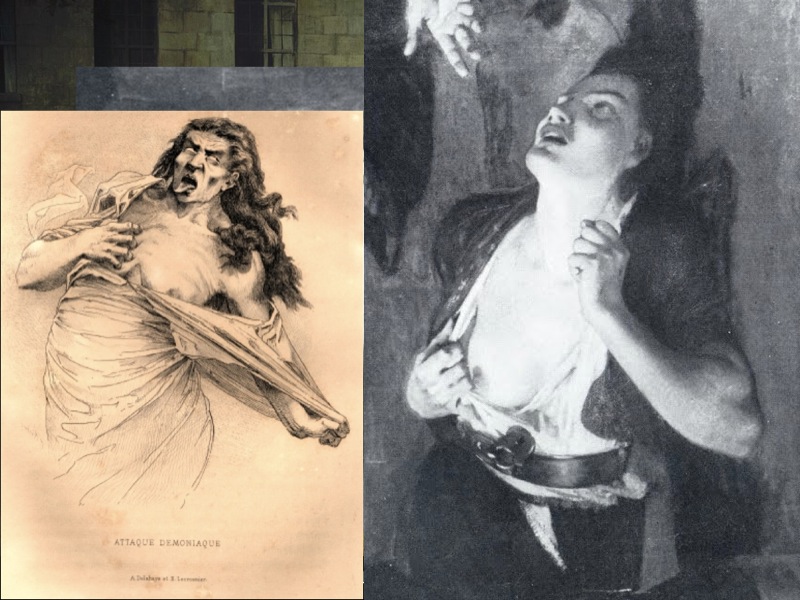
By the way, I show you this painting done by Tony Robert-Fleury one year before the lesson by Brouillet : here you see Pinel, the founder of french alienism, freeing the insane in La Salpétrière. Compare the posture of the girl having an attack on the ground, and the drawing by Richer. I shall come back later on how painters reproduce stereotypes.
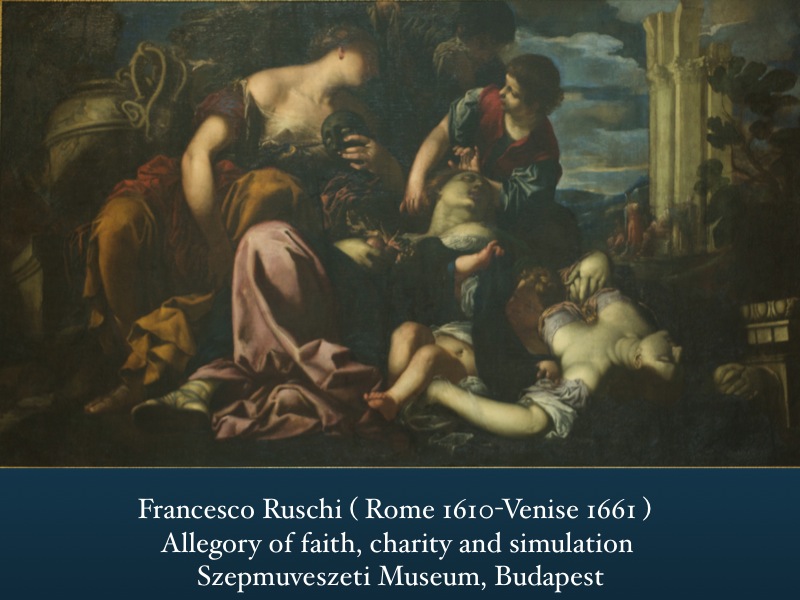
And there is something I have to tell you : two days ago, I was in the Sezptumvezeti museum of Budapest, to see this extraordinary painting by a venetian artist, Francesco Ruschi, an allegory of Faith, Charity and Simulation - usually it's Faith, Charity and Hope. Why Simulation ? Why an unusual vice with two virtues instead of three ? No one has written a line on this enigma as far as I know. Look at this posture. This painting was done in the mid seventeenth century.
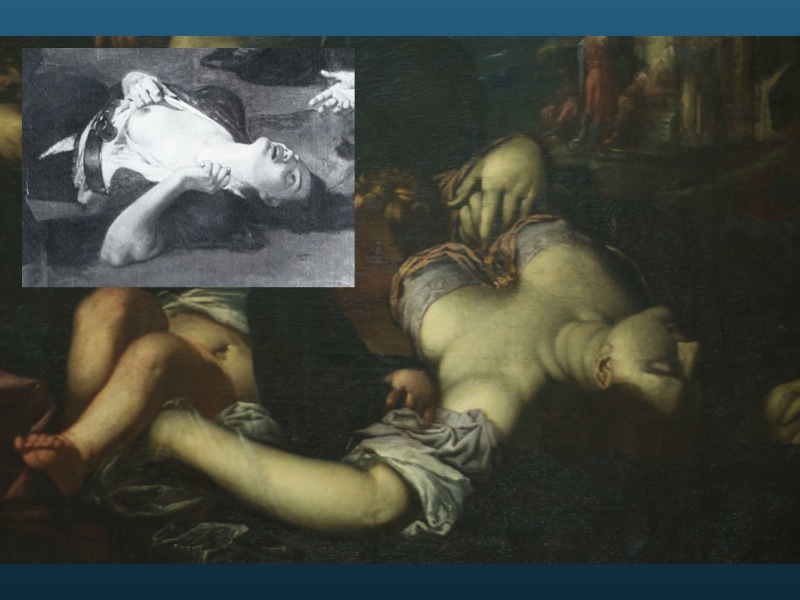
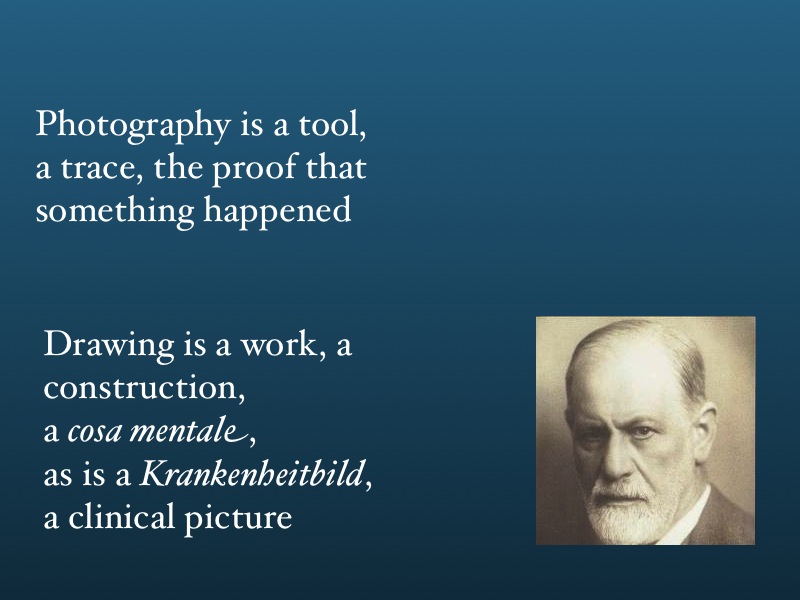
In other words : photography is a tool, a trace, the proof that something happened, that you could store in files, in the archives. While drawing is a work, a construction, a cosa mentale. Let me call for the second time Sigmund Freud, who wrote about Charcot that he was a Krankenheitbilder, working on diseases depiction, while he, Sigmund Freud, was a Krankenheitgeschichter, working on symptom’s history.

So now let's examine an idea which is a cliché for more than one century : all this was just a kind of a fake.
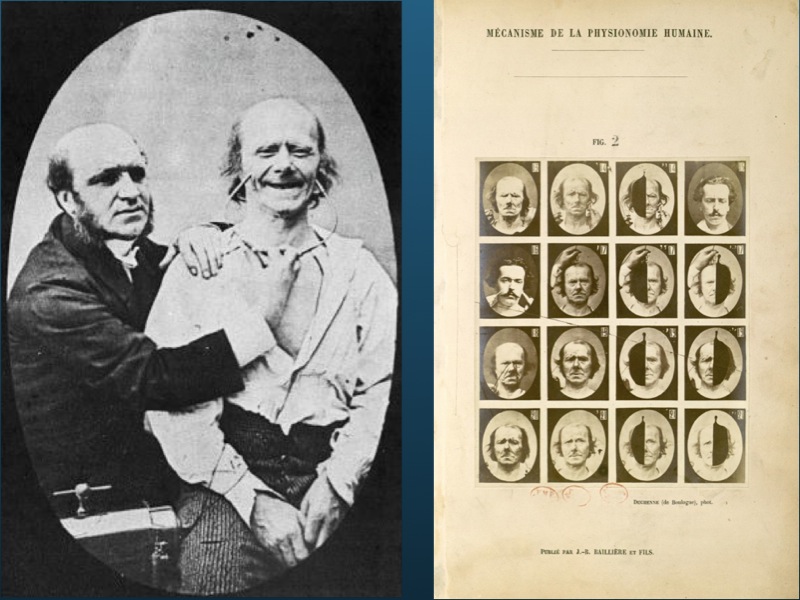
Of course, this was all set up. Look to this smiling guy : how could you reproduce this perfect Duchenne's smile with only two electrodes ? Do you know what kind of full-time job he had ? He was an employee in a circus.
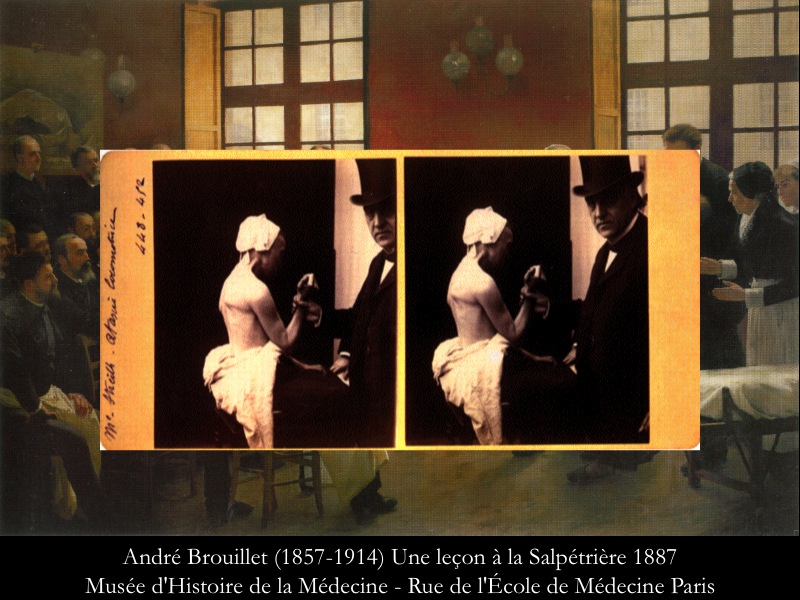
And Charcot, was he himself acting as a show director ? Like a cabaret manager, with his top hat and his stick? Here is the only picture we know of Charcot in the compagny of an unfortunate ataxic patient, not a danser.
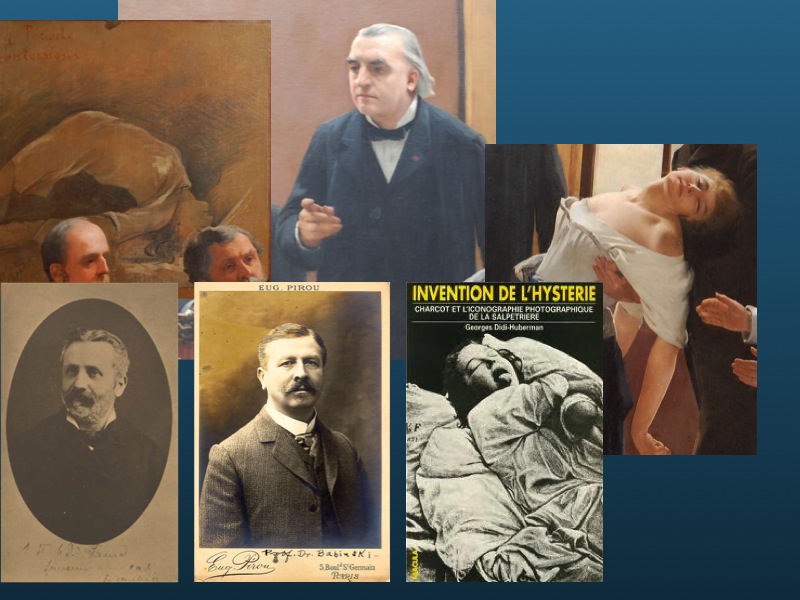
For here is at last the cliché, the commonplace known by everyone here : the ready-made interpretation of the lesson à la Salpétrière. On the left, the contorsion poster hanging on the wall. On the right, facing it, Blanche Wittmann, reproducing the posture of the upper left limb. More than that, Charcot's commentaries, are suggesting to Blanche Wittmann what to do, how to behave. Who said that ? Paul Bernheim, of the Faculty of Nancy, in the East of France, who was a tough adversary to Charcot ; Babinski himself, after the death of his master, took distances from this conception of hysteria. For them, it's a matter of imitation, of suggestion, of pathomimia, of pithiatism, if not simulation, malingering. And nowadays, the invention of hysteria by Georges Didi Huberman, translated in english and in german, demonstrates that all this was a cultural artefact, a production organised by Charcot and his collaborators with the great help of photography.
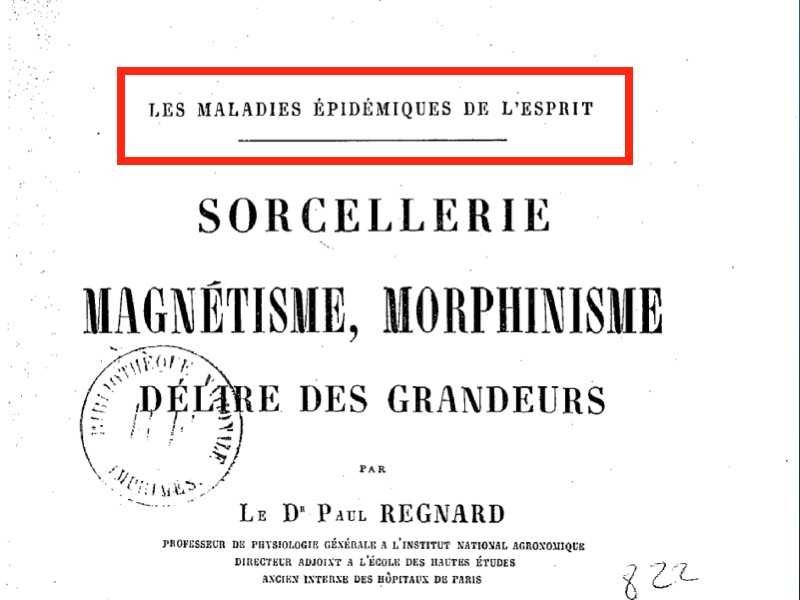
Here I should add that imitation was a very important concept all through the nineteenth century : from psychiatric, sociological, and epidemics points of view. One thinks about modern memetics. Even Paul Regnard, the first photographer we met, wrote a book about epidemical diseases of the brain.

Back to the poster ; let's focus on this detail : the forearm, as Richer drew it. I turn it a quarter-turn on the left, and I place next to it the homologous detail of Brouillet's painting. What would you say ? Well, Brouillet, this academic painter, who had been criticized a lot for his lack of genius, reproduces very well the drawing of which he took inspiration. Is this an imitation of Richer by Brouillet ? Yes and no. Of course you recognize the same forearm but the technic is different. Aswell as the organisation of the painting : here we have recognized one of Brouillet's trick : Blanche falls in the arms of Babinski, not in those of the spinster.
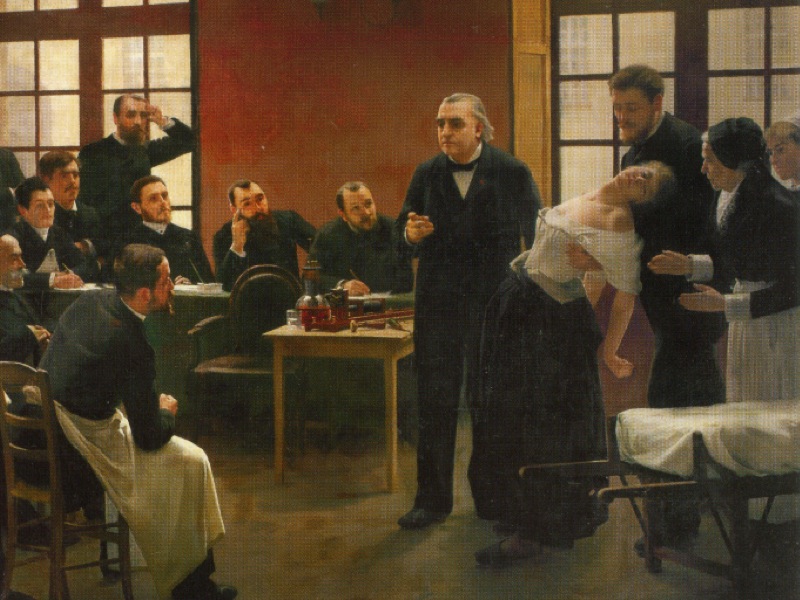
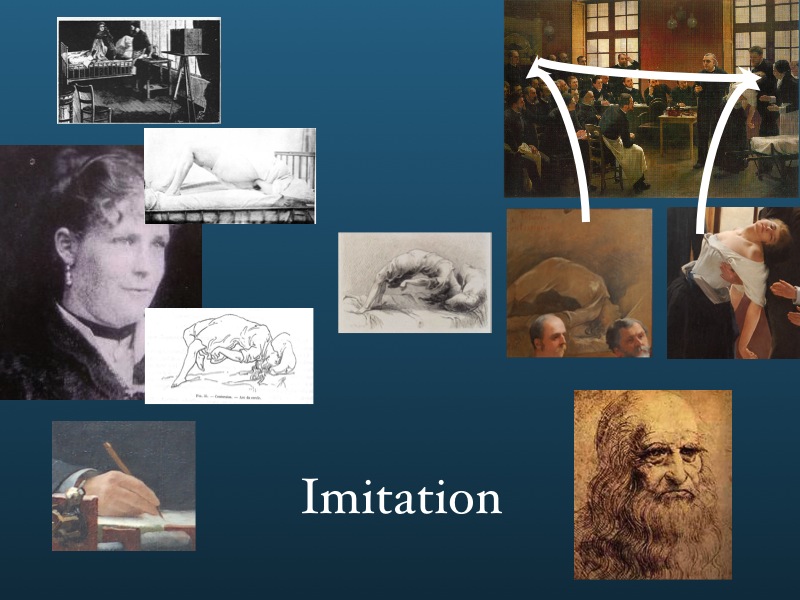
How works the cliché ? Here is Blanche Wittmann, when she was doing fine. Someone at the bedside is waiting with a pencil for her to have a fit, and does a sketch of it. Someone is waiting for her to have an attack, and takes a photography of it. Then, a sequence of reproductions : the drawing, the poster, and the painting by Andre Brouillet. Which is a cosa mentale. The intern organisation of the painting has been setup by Brouillet, not by Charcot. The idea is that the poster influences Blanche Wittman's behaviour. The link between all these steps ? Imitation.
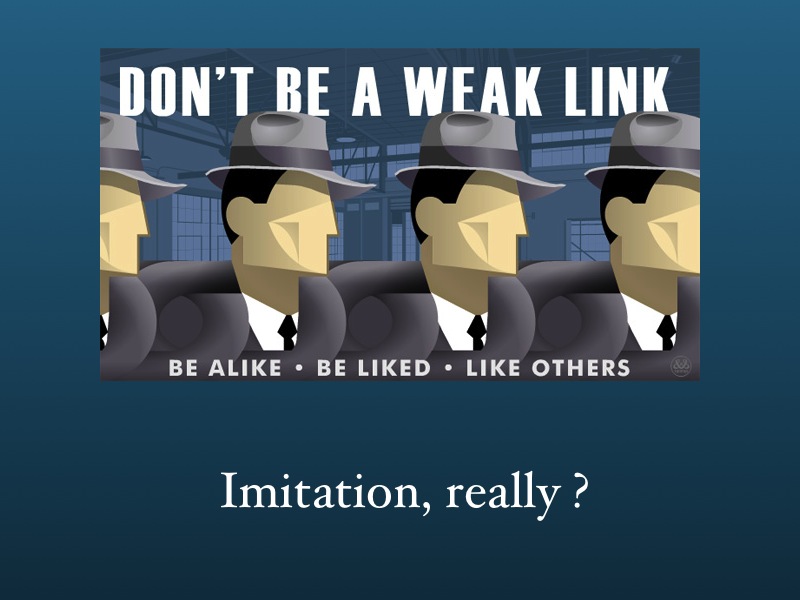
And this is in my opinion the weak link. Imitation, really ? Let's take some example.
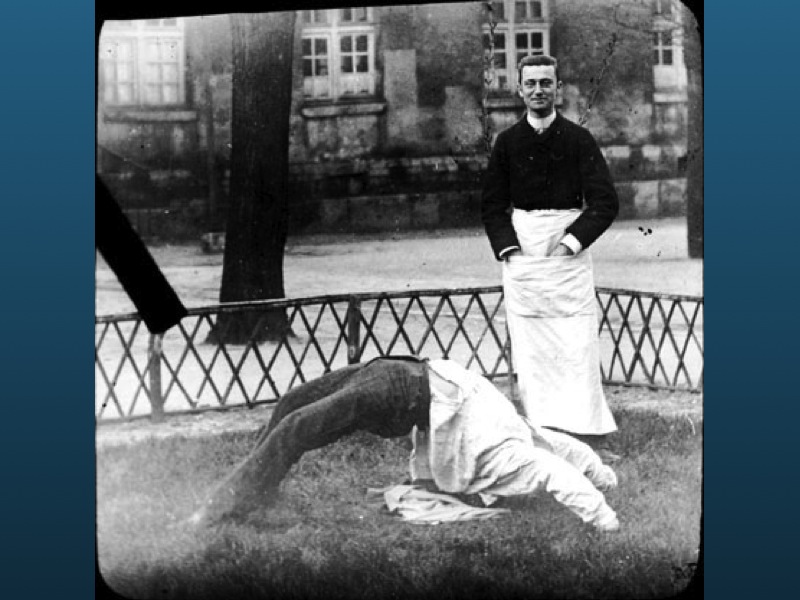
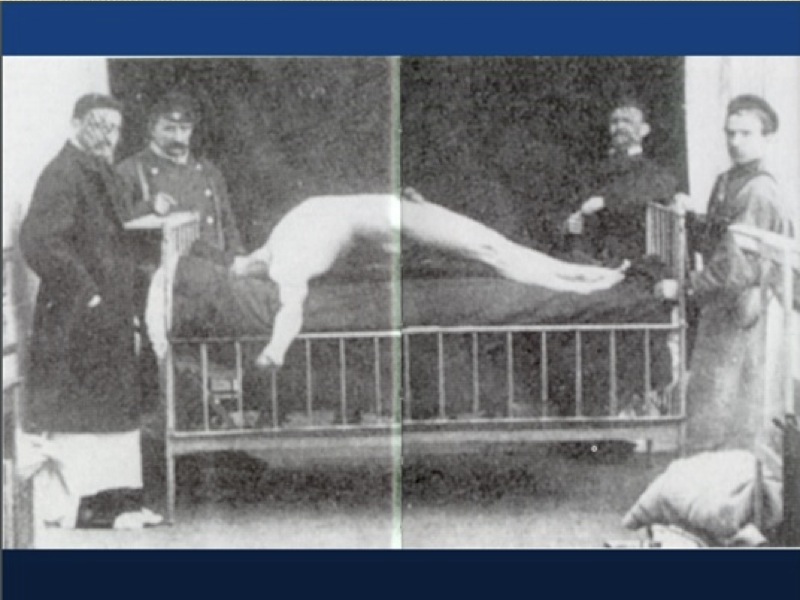
Could you do this, or that, tonight, in your bedroom, more than two minutes, without calling emergency services ? While the men kept these pseudo-opistotonos for hours and days !
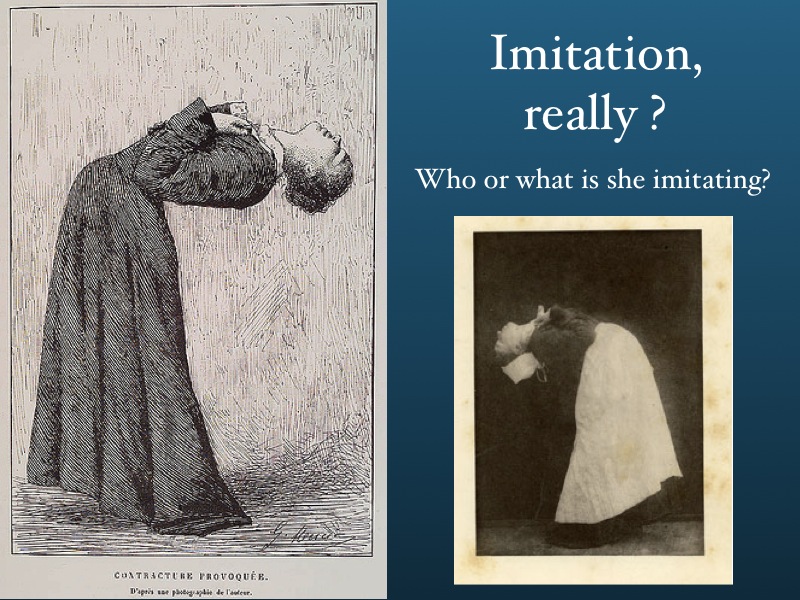
Now, is this an imitation ? I can hear some saying : but this is exagerated, it comes straight from the imagination of the artist... Really ? And what about this photograph, of which you understand the function ? Who or what does this girl imitate ?
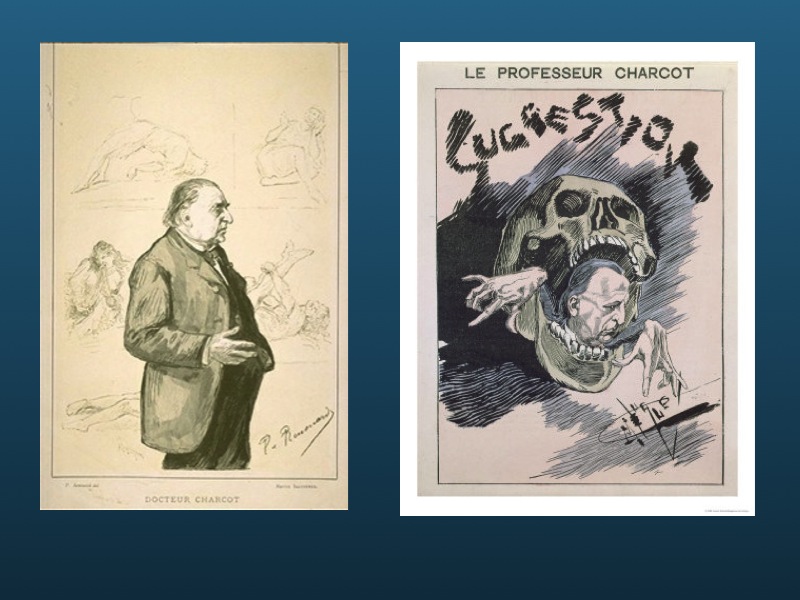
Nevertheless, Charcot has been charged with the heavy accusation of influencing patients with suggestion and power of imitation.
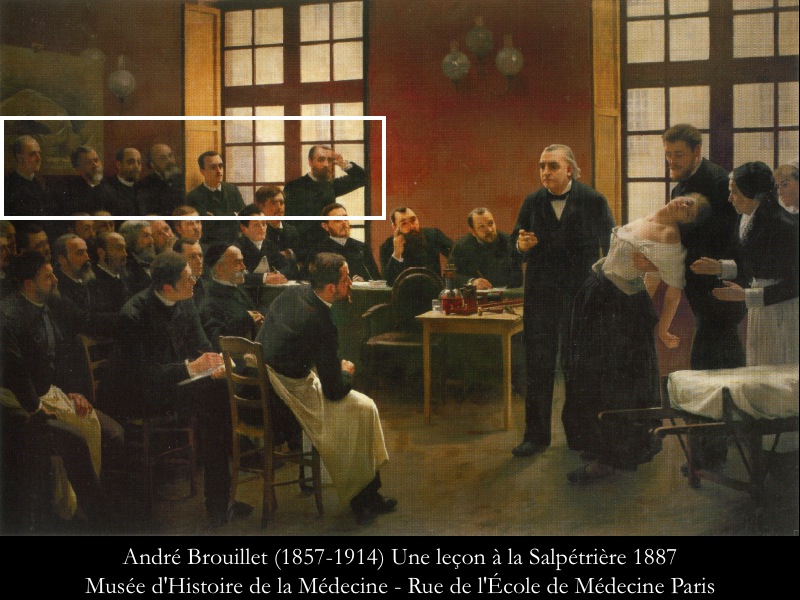
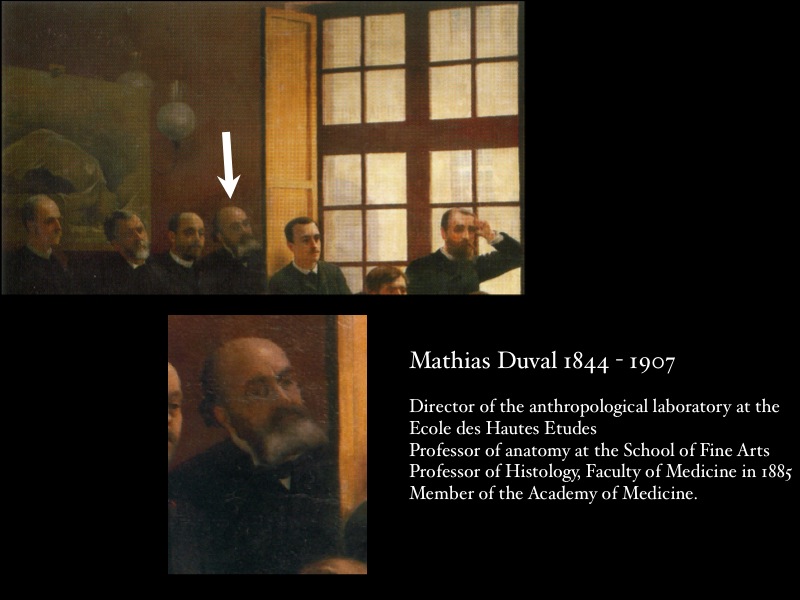
Talking about imitation, I would like to end my speech with a last come back to Brouillet's painting : look in the background, this man who seems really sleepy if not sleeping : believe me, I took the picture myself, his eyes are shut. His name is Mathias Duval who was both teacher of histology at the faculty, and teacher of anatomy at the Fine-arts school, as did Richer. Histology and hysteria are not really fields of close interest, and so you will understand why he would be better in his bed. I don't know how he reacted to Brouillet's painting, the day he discovered it.
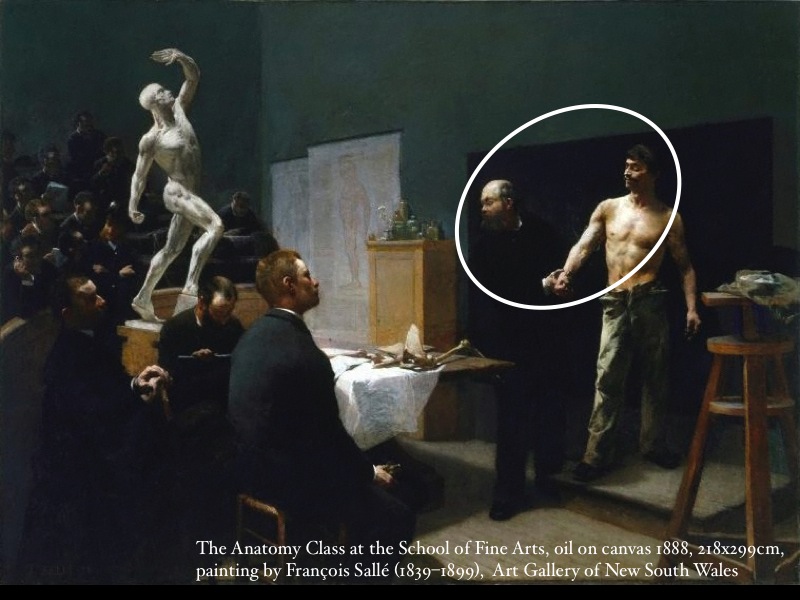
Now here is another painting, The Anatomy class at the School of Fine Arts, done the year after the lesson in la Salpétrière, in 1888, by François Sallé, a completely unknown french painter. See this couple, and now let's come back to the lesson : you feel that something is happening. Let's compare Brouillet, at the bottom, and Sallé, at the top.
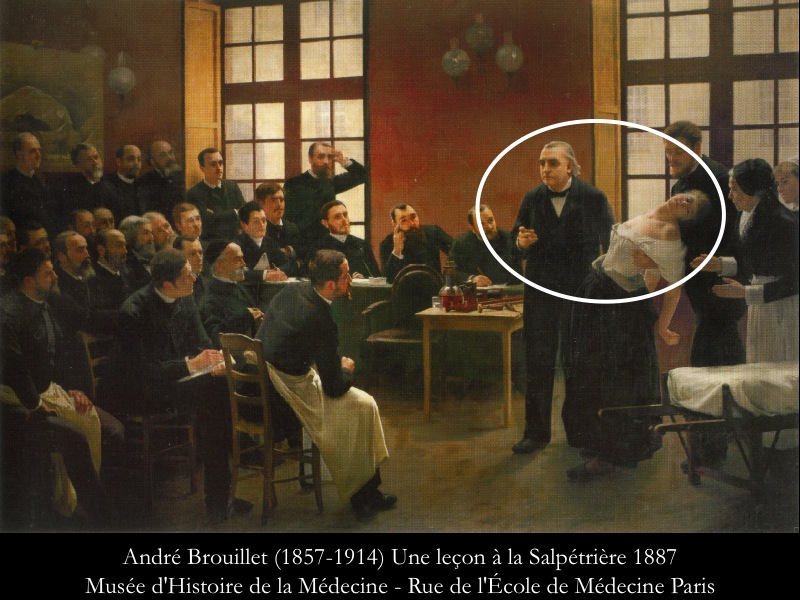
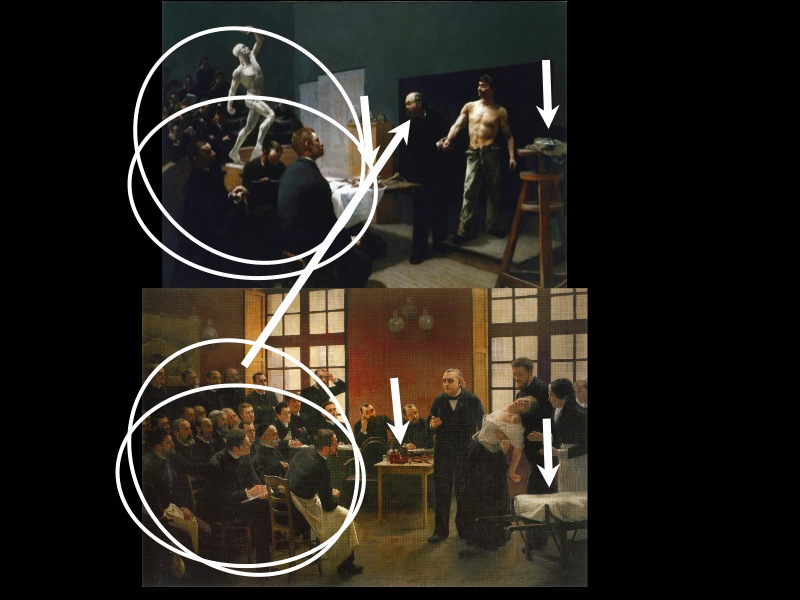
See this sleepy man how he looks perfectly awake now : here is Mathias Duval who teaches anatomy at the school of fine arts. Let's keep on comparing : here the audience stands on the left, there also ; here they are three in the front row, the one in the middle is taking notes ; there they are three, and the one in the middle is sketching. See a small table here, a small table there. Here, something to support a vase, a bench of flowers or fruits, some object to be sketched ; and there, the stretcher to receive the top-model, I mean Blanche Wittman. It works too when you start from below : Charles Féré is holding his head with his hand ? There must be above someone in the same posture. And there is at last and at least one sleeping man.
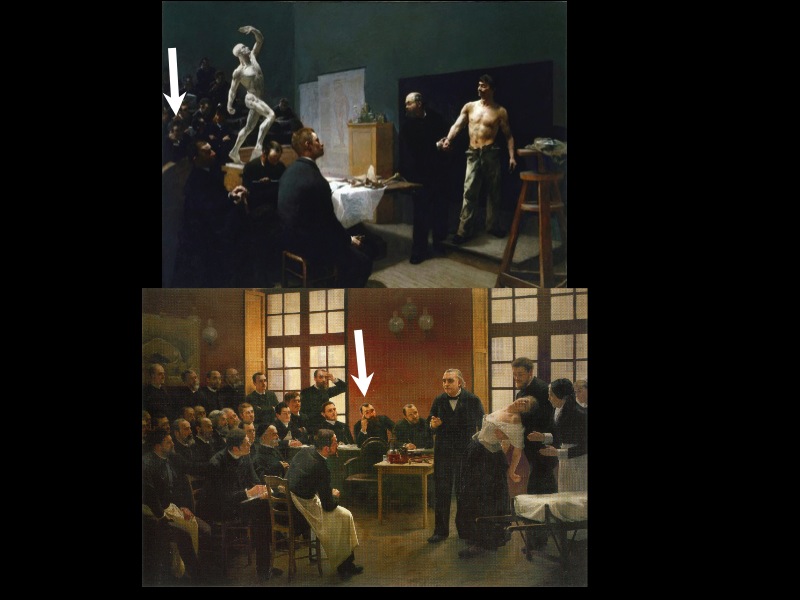
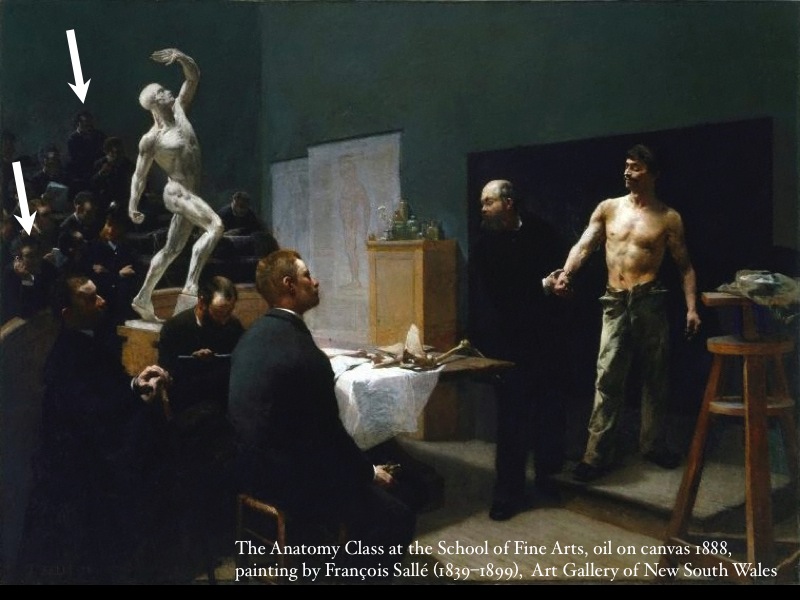
What do I want to suggest ? Brouillet should have maybe sued Sallé for plagiarism ? Not at all, even if it has been done, for less than that, more than once in history of art. But this is not plagiarism. This is History of painting : think of the same subjects treated by hundreds of painters, think about the thousands of Madona and child, the hundreds of Suzanna and the elders, of Nativities, of Solomon's judjements...
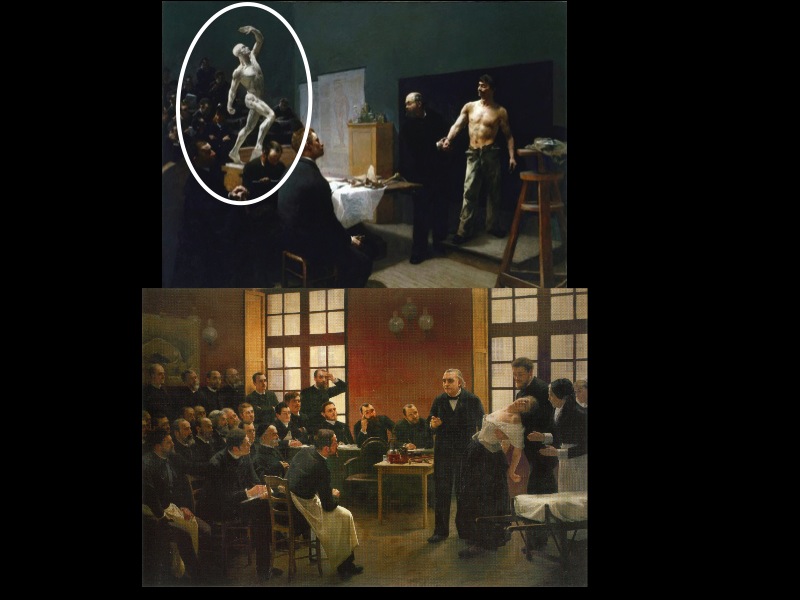
Sometimes there are slight differences, sometimes a big mutation. Now I would like to show you something interesting : the meaning of this statue. It's very common to find a statue in a school of fine arts.
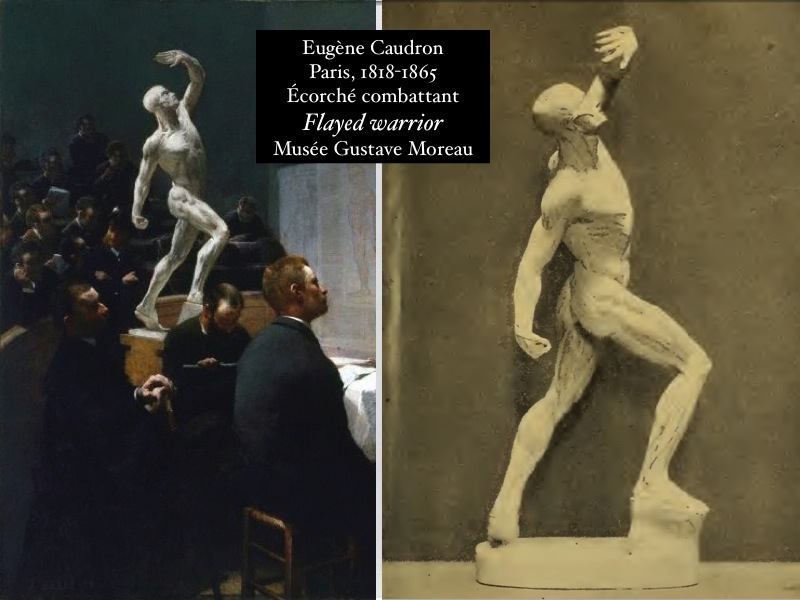
The original statue was the flayed warrior by Engene Caudron, a french artist.
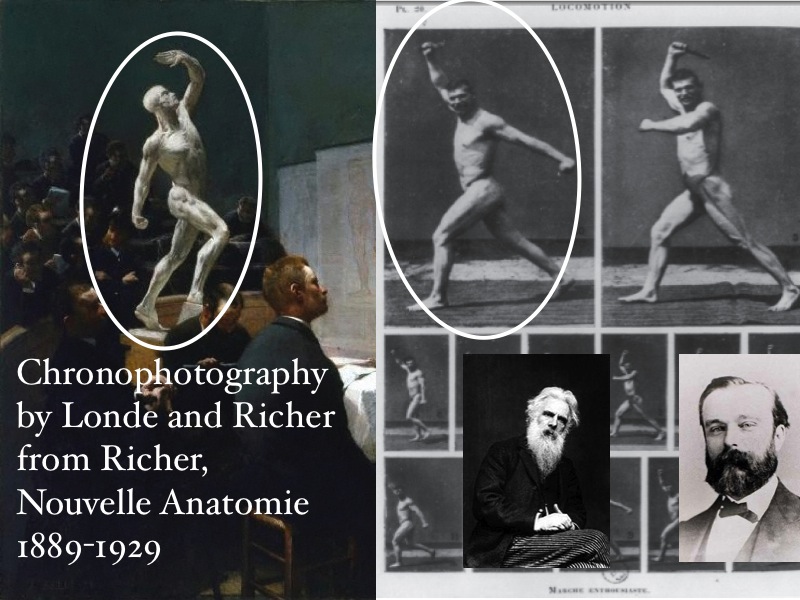
But look to this first publication in 1889 by Londe the photographer and by Richer the neurologist about the Chronophotography : the study of movement by a photographic device, invented by Muybridge and Marey. Don't they look the same ? Here is a main idea : academic artists as Richer, Brouillé, or Duval are still promoting art as a process of imitation of the ideal Beauty, and beyond, of the ideal Movement, in a pure platonician spirit.
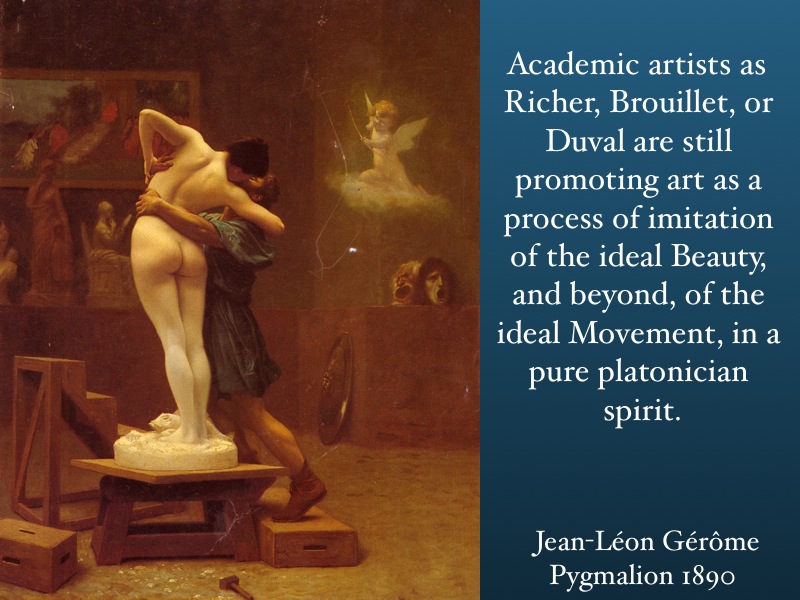
Here his the myth of Pygmation, illustrated par Jean-Léon Gérôme, a very academic painter too.
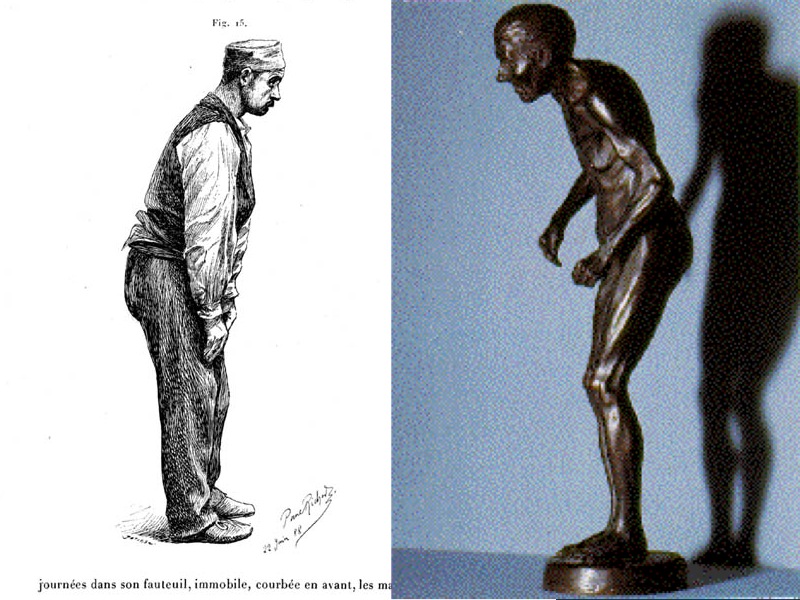
I come back to Richer. When working in hospital, he was facing ugliness, diseases, illogical attitudes, lack of movement, slowness, stiffness... : have a look to this very famous drawing and this statuette of parkinsonian patients.
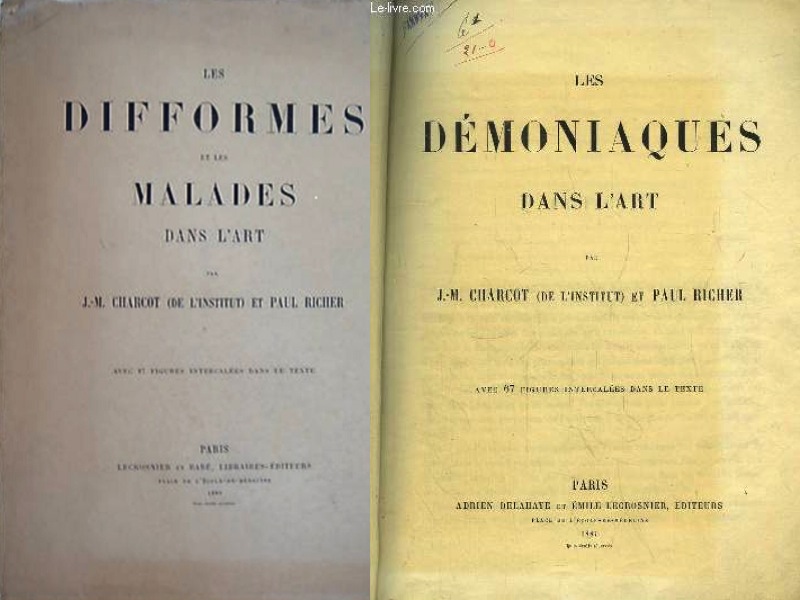
With Charcot he wrote books about deformities and demoniacs in art. But when at the School of fine arts, he used to teach about ideal proportions of men's, women's, children's bodies.
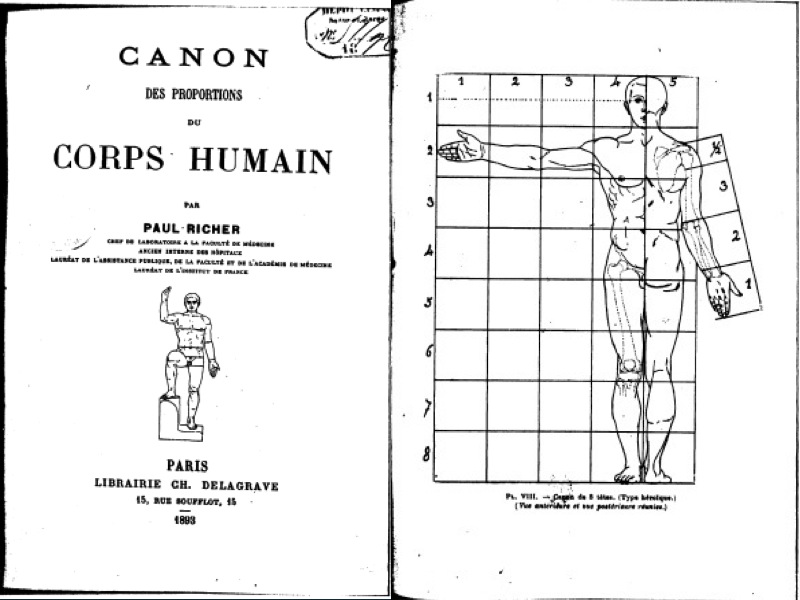
The point that could have been interesting is the shifting from proportions to movement.
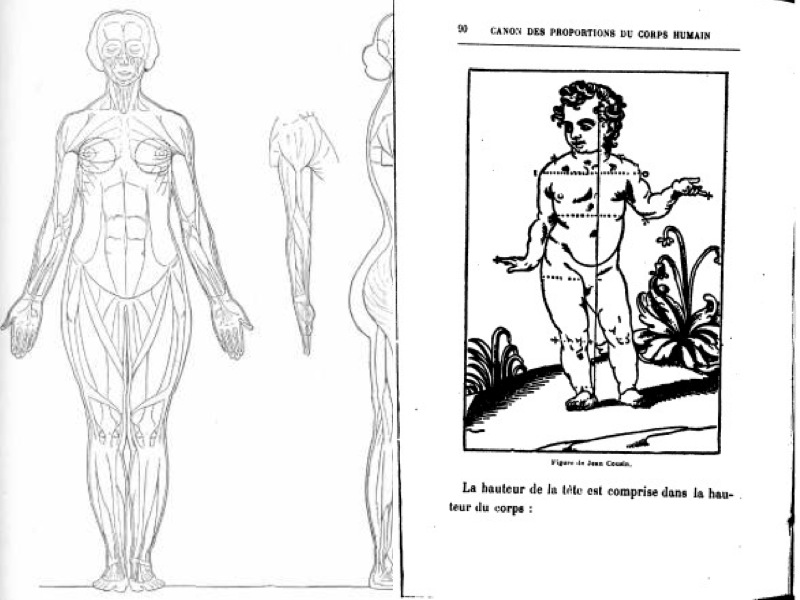
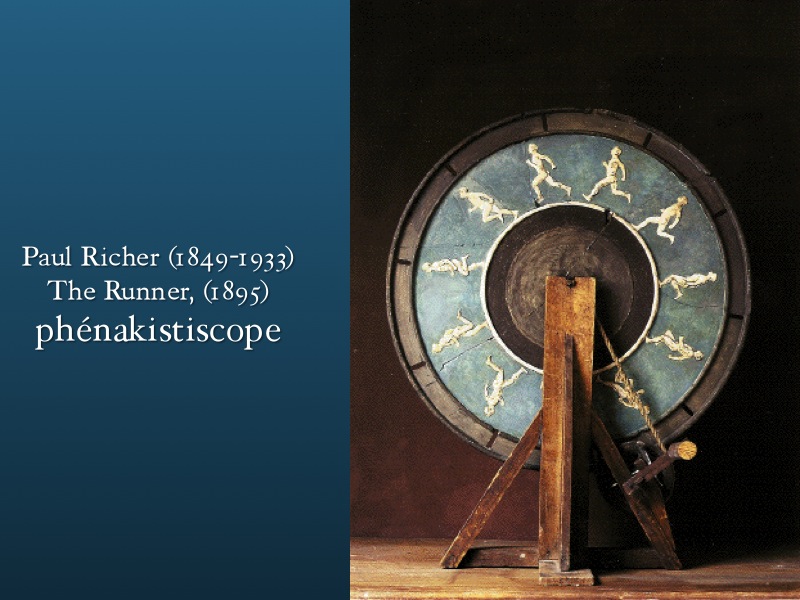
Here his a device to study movement used by Richer in 1895, the phenakistiscope.
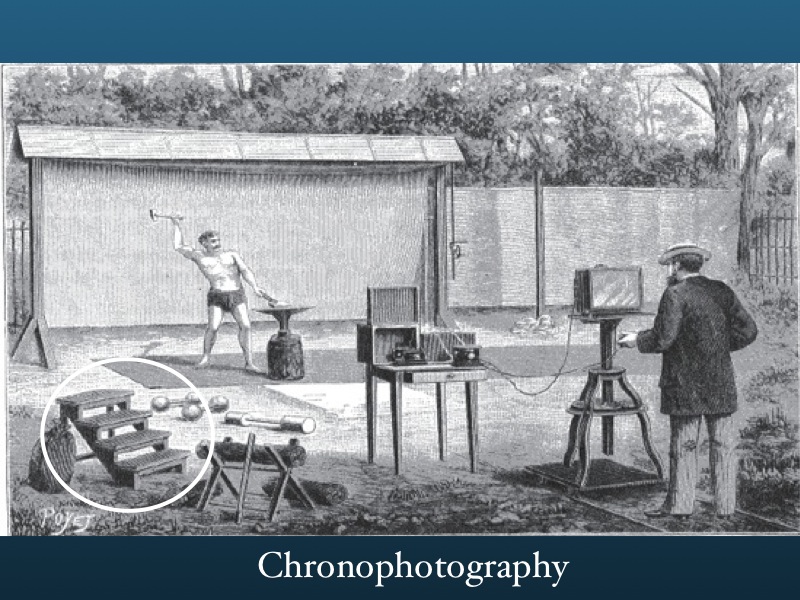
See how they proceeded for chronophotography. You notice this little staircase here on the left. It was used to study this man climbing down. Muybridge had already done the same in the eighteen seventies.
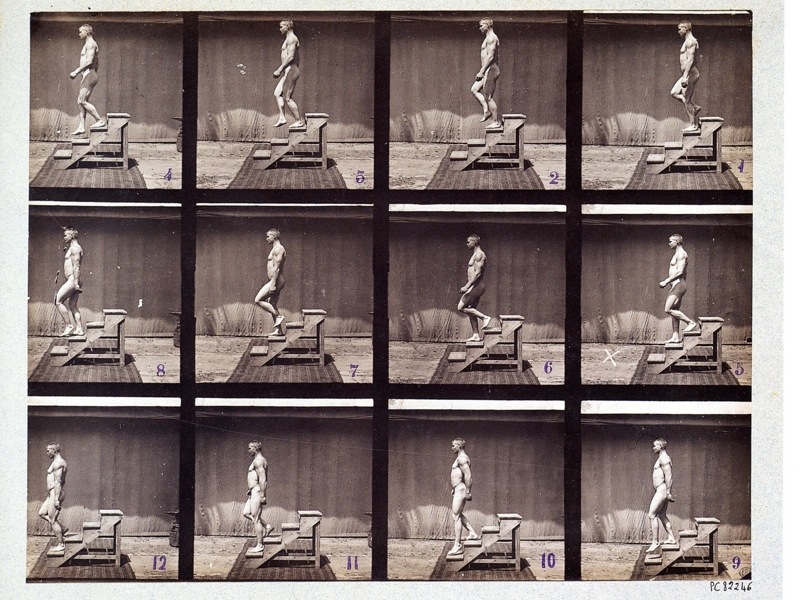
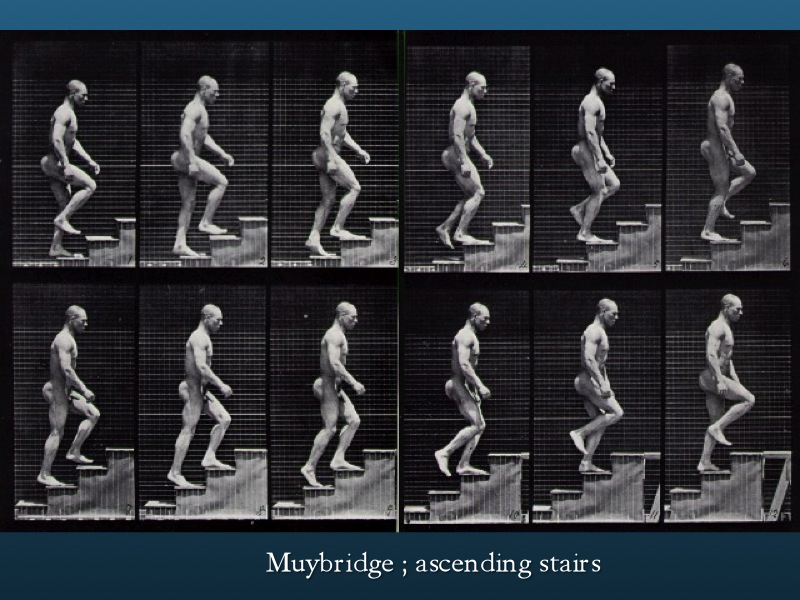
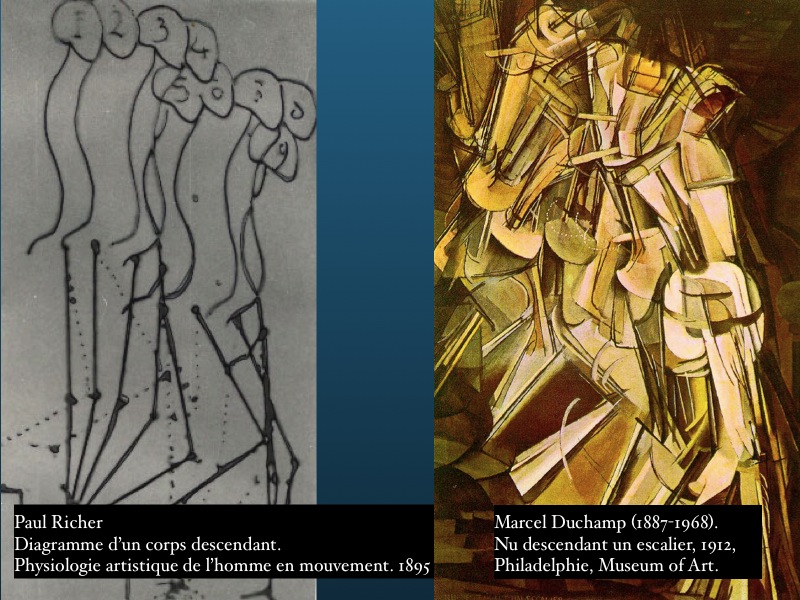
Now here is a sketch done by Richer in 1895. And then this very famous painting done in 1912 by the pope of surrealism : Marcel Duchamp.
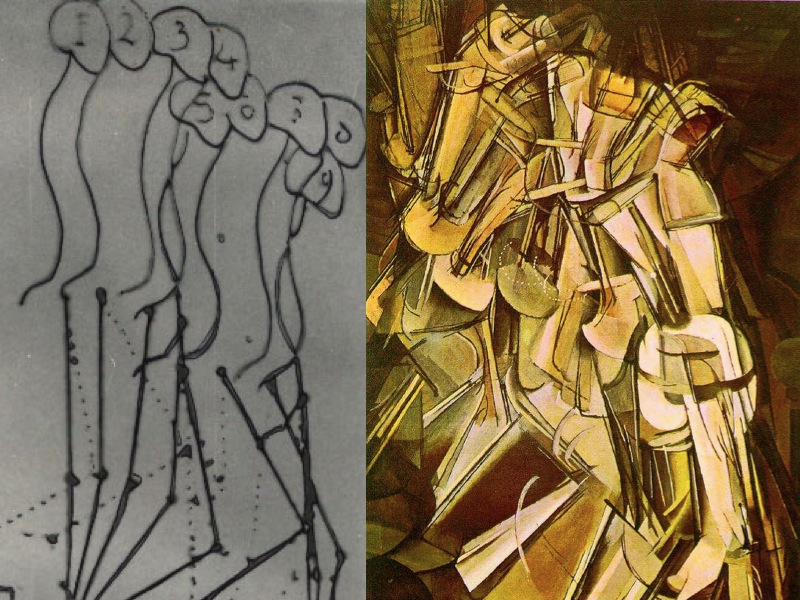
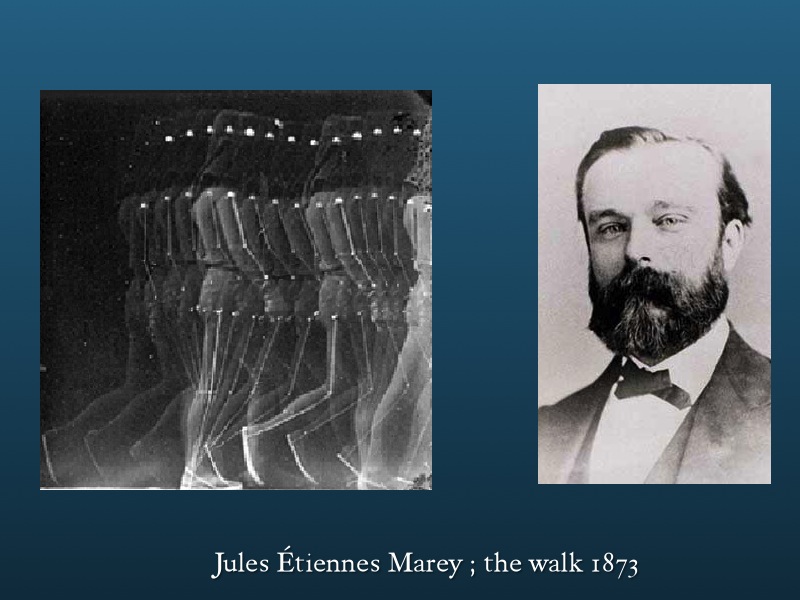
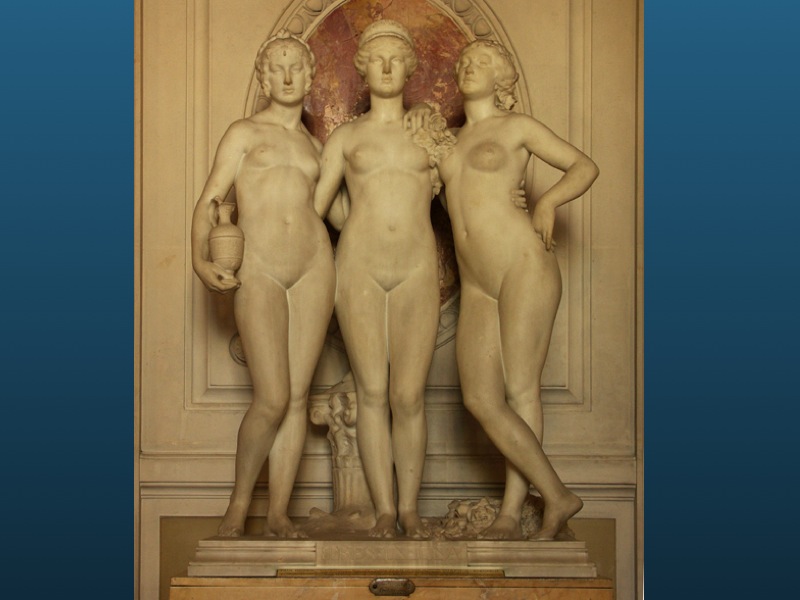
So Richer could have been an avant garde precursor ? But Marey has already published The Walk in 1873. Richer was not, definitely, an avant-gardist but a very academic artist. Here is his most famoust work, his master-piece, Tres in una : a sculpture that Paul Richer performed in 19101. Paul Richer represented, according to his own conception of art, the ideal of the female nude in three epochs: Antiquity, Renaissance and Belle Epoque.
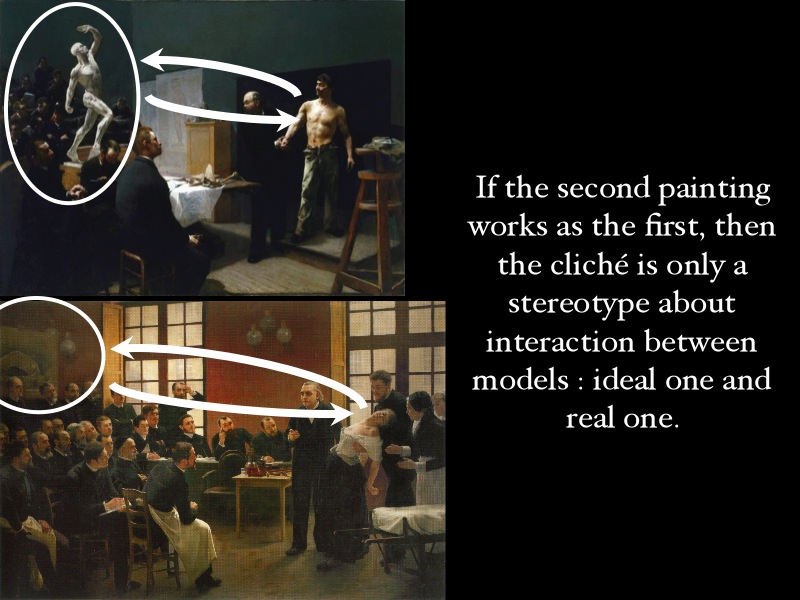
Back to the paintings, cose mentale : I have to admit that one may think that the sculpture in the upper part plays the role of the poster in the lower one, as a model. But these are ideas of painters, put in shape on the canvas, not a plot set up by Charcot.
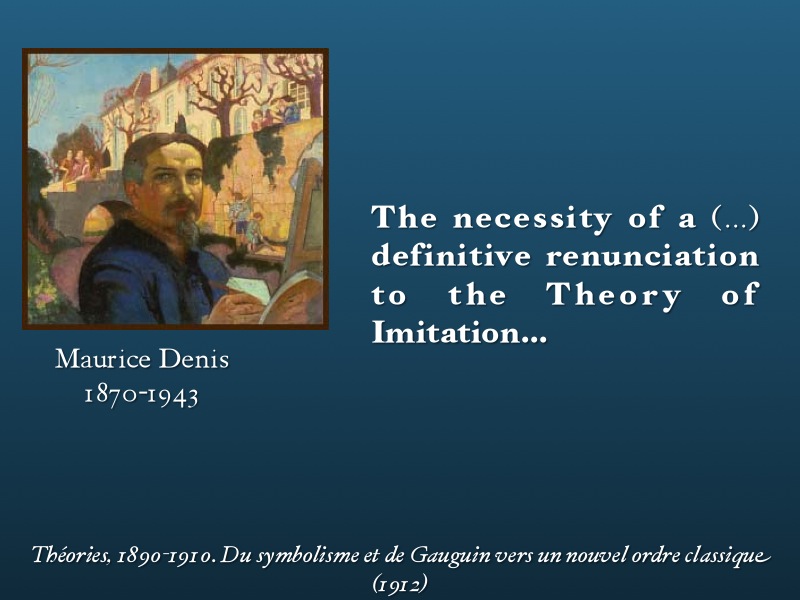
A few years later, in 1910, the french painter Maurice Denis would write about the necessity of a " definitive renunciation to the Theory of Imitation, which is based on this hypothesis that it exists somewhere deep inside the human consciousness for every object which falls under the glance, an ideally beautiful perfect type of this object. " He adds " This aesthetics claims to obtain the emotion of Beauty by the reproduction of natural objects, but embellished, idealized, according to certain rules". Let's have a last close look to the painting by Sallé : see the posters on the wall. They are illustrations of the classic proportions theories.
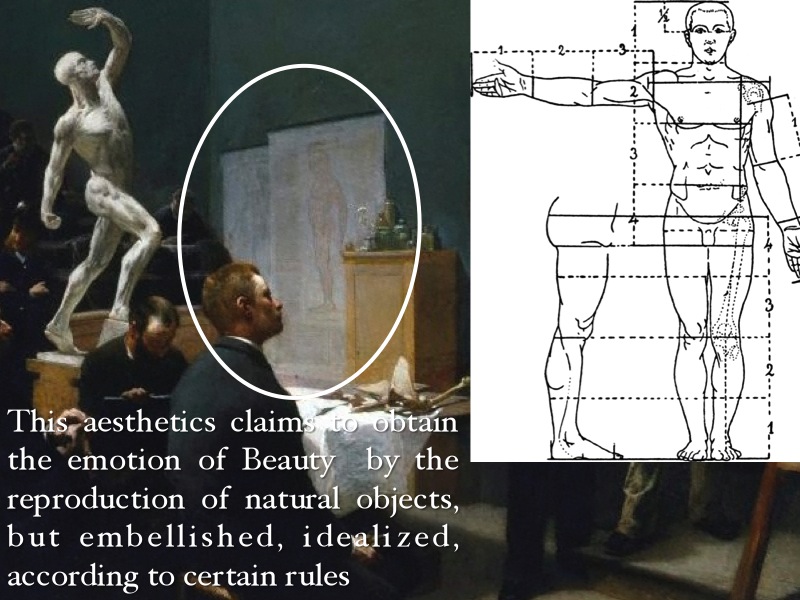
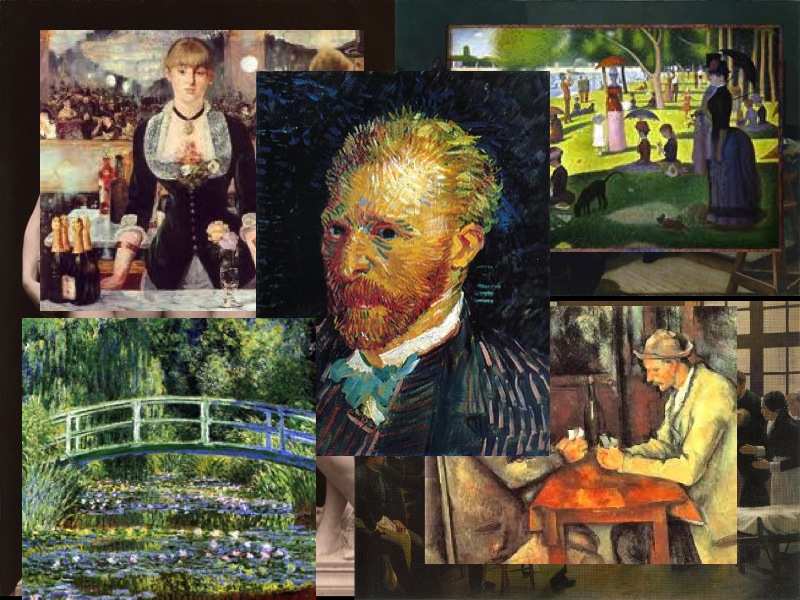
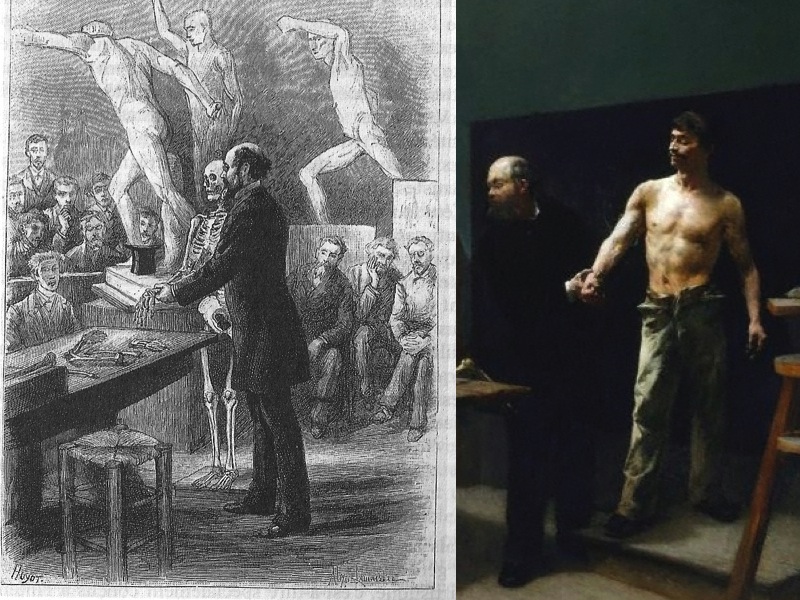
I would like to fend my talk with André Brouillet and François Sallé : they both have given to see the ultimate phase of this period dominated by stereotypes built by means of dogmas. Here is an ironical drawing where Mattias Duval is presenting a skeleton instead of a living model2.
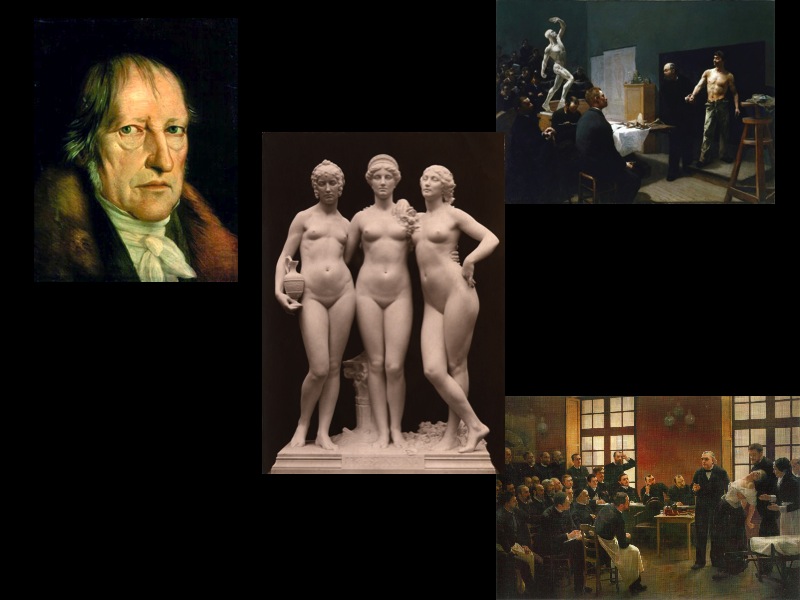
From the point of view of the history of ideas, in these two very academic works, aswell as in the esthetical production of Richer, is staged the end of a time. I shall remind simply that for Hegel, the work of art is not a reflection, not an imitation, but the revelation of an underground way of thinking, on the intuitive mode, there where the philosopher uses concepts.
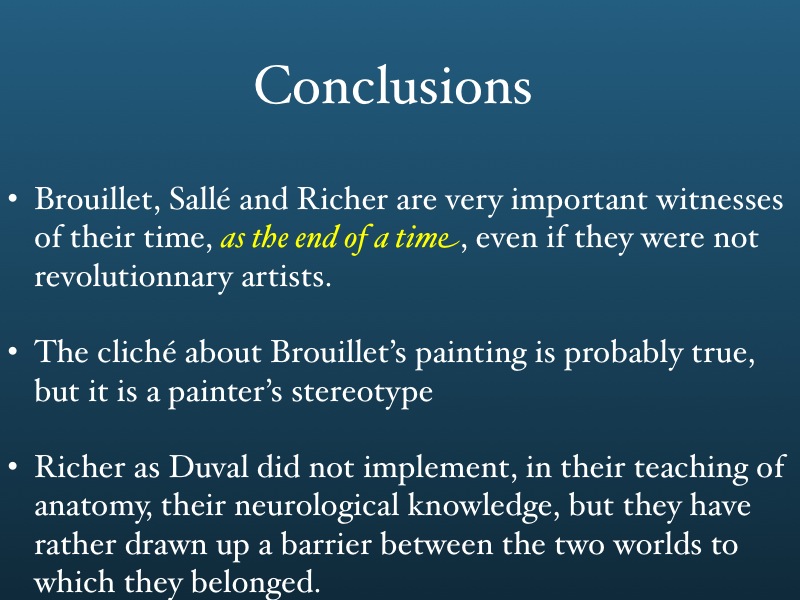
Leaving Hegel's conception, teleological vision of History, and according to the views of evolutionnary epistemology, which is interested in the coexistence of theories at one time rather than in a very hypothetic linear progress of Art, Brouillet, Sallé and Richer are very important witnesses of their time, as the end of a time, even if they were not revolutionnary artists. The second conclusion is that Richer as Duval did not implement, in their teaching of anatomy, their neurological knowledge, but they have rather drawn up a barrier between the two worlds to which they belonged.

If ever you are interested in building bridges between Neurology and Art, you might visit this website : Neuroland-Art. Our patron saint is Paul Richer. Unfortunately it's in French. But with the help of some Translator, it could get a magyar look.
I thank you for your attention.



Some important people are missing : among those, Vulpian, the main collaborator of Charcot on the topic of Multiple Sclerosis, who died in may 1887, that year Brouillet has done the painting. This is a plaster by Richer for the his commemorative statue.

Here are some early illustration of multiple sclerosis lesions. Carswell’s, in 1838. Babinski’s thesis in 1885. Vulpian pointed out, in his lessons, the polymorphism of the clinical picture, as a consequence for the anatomical variability of the lesions, both in number and in localisation. Following Vulpian, it was sometimes if not often impossible to do the diagnosis while the patient was alive.


Another point of disagreement between Charcot and Vulpian was the nature of hysteria. Here is a quotation from Vulpian's medical lessons : « Hysteria is such a common neurosis that it's not surprising in to observe some overlap between this disease and multiple sclerosis. » Vulpian, aswell as Sydenham two centuries before, thought that Hysteria was nothing but a chameleon-like disease, the great imitator.


It started with the reading of Ordenstein thesis. Ordenstein was a german student, who has done a thesis under Charcot's direction, about the differential diagnosis between shaking palsy and multiple sclerosis. If someone tells you nowadays that he has a problem distinguishing parkinson from multiple sclerosis, it may sound strange even if we know that this happens occasionally.

To understand why this differential diagnosis was such a problem in 1868, one must first go back in the passed, exactly in 1862 when Charcot arrived in la Salpétrière, a little town in the big Paris, with a church, courtyards, streets, small three-floors blocks, sheltering six thousand women with all kind of diseases.

Duchenne de Boulogne was running from one hospital to another and within the Salpétrière, from one block to another, carrying a box and two electrodes to test the muscles, setting the foundation for muscle diseases nosology. Duchenne was older than Charcot, and he taught him some clinical tricks in such a way that Charcot used to call him his master. One of the clinical tricks, was the feathered hat sign : look at the poster by Henri de Toulouse Lautrec: You see this woman wearing a hat with a high feather on top of it. Her name is Jane Avril, a former cabaret dancer, then an in-patient at the Salpetriere, and at the end she was taken in by prostitutes. Duchenne would say to Charcot : to amplify a tremor, for a better analysis, you should set on top of the head of your shaking patients such a feather. Why do I talk so much about feathers?

There is a very important paragraph in the thesis of Ordenstein : every word here is important. « We do not conceal that it is illogical to pretend to establish a parallel between shaking palsy and multiple sclerosis, since the first condition indicates in the current state of science, a functional disorder, while the other refers to a lesion of nervous tissue producing a set of symptoms somewhat resembling shaking palsy ». Shaking Palsy - Parkinson disease - was then a functionnal trouble (no lesion has been found yet in Parkinson disease) while multiple sclerosis was a lesional disease ; but both they led to the feathered hat sign : they provoked both the same kind of symptoms.

Now let's leave the subcortical level - the level, in Charcot's thought, of motricity, sensitivity, coordination, stiffness... and let's jump to the level of hysteria. Which is, following Charcot's conception, a functional disorder of the cerebral cortex. Here is a very appropriate work by Octave Charriere, published in 1882, about the overlap between hysteria and general paralysis, which was called Bayle's disease or Dementia Paralytica at the time. In France, the syphilitic origine of it was not yet admitted by the most influencial specialists. So you realise that Octave Charriere's memoir plays the same role, between hysteria, functionnal cortical disorder, and dementia paralytica, lesionnal disase of the brain cortex, than Ordenstein thesis, between Parkinson considered at the time as a functionnal disorder, and Multiple sclerosis, paradigm of subcortical lesionnal disease. And now you see the potential strategic importance of Multiple Slerosis in the progression of Charcot's thought.

Let’s get back to the Lesson of Brouillet : obviously there are different groups. Some standing people on the background on the left, not very attentive ; a sitting group, at the right of Charcot ; the very attentive ones, they sit in the foregroung on the left, listening to Charcot's commentaries about Blanche Wittmann, one of the stars of the Salpétrière's hysterical team at the moment.



She falls in the arms of Babinski, and not in those of Marguerite Bottard, the oldest of the two nurses who stand ready to rescue her ; nor on the strecher, waiting on the foreground, just in case. Here you see Blanche, Blanche and Babinski, and the most known superior limb of neurological history : look at the forearm, wrist, fingers, one could talk about a kind of dystonic posture.

The all of you know that a picture is hanged on the opposite wall. If you have good eyes you can read : period of contorsions. It's a pseudo-opistotonus. Not a real one, as we know since this wonderful and awful illustration of tetanus by Charles Bell himself : here you see the unfortunate english soldier suffering from tetanus. The contraction of the forearm is different.



Who did this poster ? Paul Richer. It's time to tell you a little bit more about him. Paul Richer was very gifted for drawing aswell as modeling ; he was asked by his friend Paul Meillet to illustrate a thesis about The permanent deformations of the hand. At the origin of the thesis was Jean-Martin Charcot, who, enthused by the drawings, would have say : one could make the diagnosis on these drawings !






Thus, Paul Richer began writing a thesis, A Descriptive Study of the great hysterical attack, following the two main ideas of Charcot : Hysteria is a real disease, and hysteria does not mimic any other disease. In order to demonstrate that the great hysterical attack followed a constant pattern, they distinguished four periods, eight phases.


Look at this pannel of sketches all done by Richer himself : they are organised in four periods, epileptoïd, clownism, passionate attitudes, delirious.


How Richer did to catch all these illogical attitudes, as he used to call them ? He would stay for hours at the bedside, for example, at Suzanne's, who experienced on the 28th of june 1879, a cluster of attacks, which happened always as a sequence of illogical figures in the same order and in the same manner. This is exactly what wanted to demonstrate Charcot : the constancy of the pattern of the Great Hysterical Attack.

Now let's have a look to these sketches depicting what they called passionate attitudes. The word Passion is still used by Charcot and Richer, although since a long time scottish philosophers and then english men of science - I think about Darwin - use instead of Passion the word Emotion. Well passion meant at this time joy, sadness, disgust, terror, anger, asthonishment, admiration, pride, shame…


The idea of Charcot about Hysteria is that it's a disorder of the expression of passions. If I hear a sad song, I shall have a sad expression on my face. While in Hysteria, the expression happens out of purpose, out of proportion, exagerated, theatrical. Charcot wanted to brush with Richer the semeiology of pathological expressions of passions.


But sketching was not enough. So Charcot asked Bourneville, one of his earliest collaborators, to organise with the physiologist Paul Regnard and then Albert Londes the first photographical iconography department in la Salpétrière. They worked together with Richer.


Let's take an exemple of how they proceeded : this girl has an attack ; Regnard takes a picture ; then Richer makes a drawing, after the picture. Another exemple : the contortion's illogical attitude is photographied by Albert Londes, then Richer makes a drawing after the photograph. You noticed the difference of the forearm position. In fact Richer has chosen one amid two of his own sketches, rather than the photography. Here is the installation to take pictures at the bedside : Albert Londes who is wearing a small cap, an apron and a beard, is ready to press the button.

Pero por qué para Charcot son necesarios las fotografías y tambien los dibujos? ... Why Charcot needed both photography and drawings ? This is quite a good question.


Maybe there are several answers. Even before the invention of photography, drawing and painting were means to depict madness ; as this illustration of dementia, dated 1816.

These illustrations by Ambroise Tardieu for the last work of Esquirol, in 1837. I have no time to comment the marvellous monomaniacs painted by Gericault at the request of an alienist, Georget : envy, gambling, kleptomania, military commandment, kidnapping... One thing is sure : since a long time people believed that insanity was readable on someone's facial features.






On the other hand, some colleagues of Charcot used photographs but not drawings : for exemple, Duchesne de Boulogne. In his Mecanism of human physionomy, he tried to produce experimentally all kind of expressions of passions using two electrodes : joy, sadness, fear, terror, anger...



So, why both photographs and drawings ? At last a first answer : I shall call the testimony of Sigmund Freud himself, who spent four monthes, during the winter 85-86, in the department of Charcot : he used to tell about him, that he was a visual man : not in the meaning of visionary ; in the meaning of intuitive recognition of shapes. The recognition of a disease's essential features. Remember how he was astonished by the drawings of Richer.

Then a second answer. Consider this set of illustrations : first a photography of Angelique, one of the challengers of Blanche Wittmann, having a demonic attack, with the tongue thrown out of the mouth, one could think about the exorcist, the famous movie. Then the sketches done by Paul Richer. Then this very elaborate drawing.

So what is the difference between photography and drawing ? On the first you will recognize a person, you may have other pictures of the same person ; if you don't know her, you will ask, who's that girl ? But the main topic of this drawing is the idea of demonic attack, built by an artist. You don't care about who is represented : it's more a question of what is presented. Here I have to mention a very important idea that was put forward by de Alberti and Leonardo da Vinci : drawing and painting are cose mentale. Il means : constructions by the artist's mind. They are not at all some kind of imitations.




By the way, I show you this painting done by Tony Robert-Fleury one year before the lesson by Brouillet : here you see Pinel, the founder of french alienism, freeing the insane in La Salpétrière. Compare the posture of the girl having an attack on the ground, and the drawing by Richer. I shall come back later on how painters reproduce stereotypes.

And there is something I have to tell you : two days ago, I was in the Sezptumvezeti museum of Budapest, to see this extraordinary painting by a venetian artist, Francesco Ruschi, an allegory of Faith, Charity and Simulation - usually it's Faith, Charity and Hope. Why Simulation ? Why an unusual vice with two virtues instead of three ? No one has written a line on this enigma as far as I know. Look at this posture. This painting was done in the mid seventeenth century.


In other words : photography is a tool, a trace, the proof that something happened, that you could store in files, in the archives. While drawing is a work, a construction, a cosa mentale. Let me call for the second time Sigmund Freud, who wrote about Charcot that he was a Krankenheitbilder, working on diseases depiction, while he, Sigmund Freud, was a Krankenheitgeschichter, working on symptom’s history.

So now let's examine an idea which is a cliché for more than one century : all this was just a kind of a fake.

Of course, this was all set up. Look to this smiling guy : how could you reproduce this perfect Duchenne's smile with only two electrodes ? Do you know what kind of full-time job he had ? He was an employee in a circus.

And Charcot, was he himself acting as a show director ? Like a cabaret manager, with his top hat and his stick? Here is the only picture we know of Charcot in the compagny of an unfortunate ataxic patient, not a danser.

For here is at last the cliché, the commonplace known by everyone here : the ready-made interpretation of the lesson à la Salpétrière. On the left, the contorsion poster hanging on the wall. On the right, facing it, Blanche Wittmann, reproducing the posture of the upper left limb. More than that, Charcot's commentaries, are suggesting to Blanche Wittmann what to do, how to behave. Who said that ? Paul Bernheim, of the Faculty of Nancy, in the East of France, who was a tough adversary to Charcot ; Babinski himself, after the death of his master, took distances from this conception of hysteria. For them, it's a matter of imitation, of suggestion, of pathomimia, of pithiatism, if not simulation, malingering. And nowadays, the invention of hysteria by Georges Didi Huberman, translated in english and in german, demonstrates that all this was a cultural artefact, a production organised by Charcot and his collaborators with the great help of photography.

Here I should add that imitation was a very important concept all through the nineteenth century : from psychiatric, sociological, and epidemics points of view. One thinks about modern memetics. Even Paul Regnard, the first photographer we met, wrote a book about epidemical diseases of the brain.

Back to the poster ; let's focus on this detail : the forearm, as Richer drew it. I turn it a quarter-turn on the left, and I place next to it the homologous detail of Brouillet's painting. What would you say ? Well, Brouillet, this academic painter, who had been criticized a lot for his lack of genius, reproduces very well the drawing of which he took inspiration. Is this an imitation of Richer by Brouillet ? Yes and no. Of course you recognize the same forearm but the technic is different. Aswell as the organisation of the painting : here we have recognized one of Brouillet's trick : Blanche falls in the arms of Babinski, not in those of the spinster.


How works the cliché ? Here is Blanche Wittmann, when she was doing fine. Someone at the bedside is waiting with a pencil for her to have a fit, and does a sketch of it. Someone is waiting for her to have an attack, and takes a photography of it. Then, a sequence of reproductions : the drawing, the poster, and the painting by Andre Brouillet. Which is a cosa mentale. The intern organisation of the painting has been setup by Brouillet, not by Charcot. The idea is that the poster influences Blanche Wittman's behaviour. The link between all these steps ? Imitation.

And this is in my opinion the weak link. Imitation, really ? Let's take some example.


Could you do this, or that, tonight, in your bedroom, more than two minutes, without calling emergency services ? While the men kept these pseudo-opistotonos for hours and days !

Now, is this an imitation ? I can hear some saying : but this is exagerated, it comes straight from the imagination of the artist... Really ? And what about this photograph, of which you understand the function ? Who or what does this girl imitate ?

Nevertheless, Charcot has been charged with the heavy accusation of influencing patients with suggestion and power of imitation.



Now here is another painting, The Anatomy class at the School of Fine Arts, done the year after the lesson in la Salpétrière, in 1888, by François Sallé, a completely unknown french painter. See this couple, and now let's come back to the lesson : you feel that something is happening. Let's compare Brouillet, at the bottom, and Sallé, at the top.


See this sleepy man how he looks perfectly awake now : here is Mathias Duval who teaches anatomy at the school of fine arts. Let's keep on comparing : here the audience stands on the left, there also ; here they are three in the front row, the one in the middle is taking notes ; there they are three, and the one in the middle is sketching. See a small table here, a small table there. Here, something to support a vase, a bench of flowers or fruits, some object to be sketched ; and there, the stretcher to receive the top-model, I mean Blanche Wittman. It works too when you start from below : Charles Féré is holding his head with his hand ? There must be above someone in the same posture. And there is at last and at least one sleeping man.



Sometimes there are slight differences, sometimes a big mutation. Now I would like to show you something interesting : the meaning of this statue. It's very common to find a statue in a school of fine arts.

The original statue was the flayed warrior by Engene Caudron, a french artist.

But look to this first publication in 1889 by Londe the photographer and by Richer the neurologist about the Chronophotography : the study of movement by a photographic device, invented by Muybridge and Marey. Don't they look the same ? Here is a main idea : academic artists as Richer, Brouillé, or Duval are still promoting art as a process of imitation of the ideal Beauty, and beyond, of the ideal Movement, in a pure platonician spirit.

Here his the myth of Pygmation, illustrated par Jean-Léon Gérôme, a very academic painter too.

I come back to Richer. When working in hospital, he was facing ugliness, diseases, illogical attitudes, lack of movement, slowness, stiffness... : have a look to this very famous drawing and this statuette of parkinsonian patients.

With Charcot he wrote books about deformities and demoniacs in art. But when at the School of fine arts, he used to teach about ideal proportions of men's, women's, children's bodies.

The point that could have been interesting is the shifting from proportions to movement.


Here his a device to study movement used by Richer in 1895, the phenakistiscope.

See how they proceeded for chronophotography. You notice this little staircase here on the left. It was used to study this man climbing down. Muybridge had already done the same in the eighteen seventies.



Now here is a sketch done by Richer in 1895. And then this very famous painting done in 1912 by the pope of surrealism : Marcel Duchamp.



So Richer could have been an avant garde precursor ? But Marey has already published The Walk in 1873. Richer was not, definitely, an avant-gardist but a very academic artist. Here is his most famoust work, his master-piece, Tres in una : a sculpture that Paul Richer performed in 19101. Paul Richer represented, according to his own conception of art, the ideal of the female nude in three epochs: Antiquity, Renaissance and Belle Epoque.

Back to the paintings, cose mentale : I have to admit that one may think that the sculpture in the upper part plays the role of the poster in the lower one, as a model. But these are ideas of painters, put in shape on the canvas, not a plot set up by Charcot.

A few years later, in 1910, the french painter Maurice Denis would write about the necessity of a " definitive renunciation to the Theory of Imitation, which is based on this hypothesis that it exists somewhere deep inside the human consciousness for every object which falls under the glance, an ideally beautiful perfect type of this object. " He adds " This aesthetics claims to obtain the emotion of Beauty by the reproduction of natural objects, but embellished, idealized, according to certain rules". Let's have a last close look to the painting by Sallé : see the posters on the wall. They are illustrations of the classic proportions theories.



I would like to fend my talk with André Brouillet and François Sallé : they both have given to see the ultimate phase of this period dominated by stereotypes built by means of dogmas. Here is an ironical drawing where Mattias Duval is presenting a skeleton instead of a living model2.

From the point of view of the history of ideas, in these two very academic works, aswell as in the esthetical production of Richer, is staged the end of a time. I shall remind simply that for Hegel, the work of art is not a reflection, not an imitation, but the revelation of an underground way of thinking, on the intuitive mode, there where the philosopher uses concepts.

Leaving Hegel's conception, teleological vision of History, and according to the views of evolutionnary epistemology, which is interested in the coexistence of theories at one time rather than in a very hypothetic linear progress of Art, Brouillet, Sallé and Richer are very important witnesses of their time, as the end of a time, even if they were not revolutionnary artists. The second conclusion is that Richer as Duval did not implement, in their teaching of anatomy, their neurological knowledge, but they have rather drawn up a barrier between the two worlds to which they belonged.

If ever you are interested in building bridges between Neurology and Art, you might visit this website : Neuroland-Art. Our patron saint is Paul Richer. Unfortunately it's in French. But with the help of some Translator, it could get a magyar look.
I thank you for your attention.